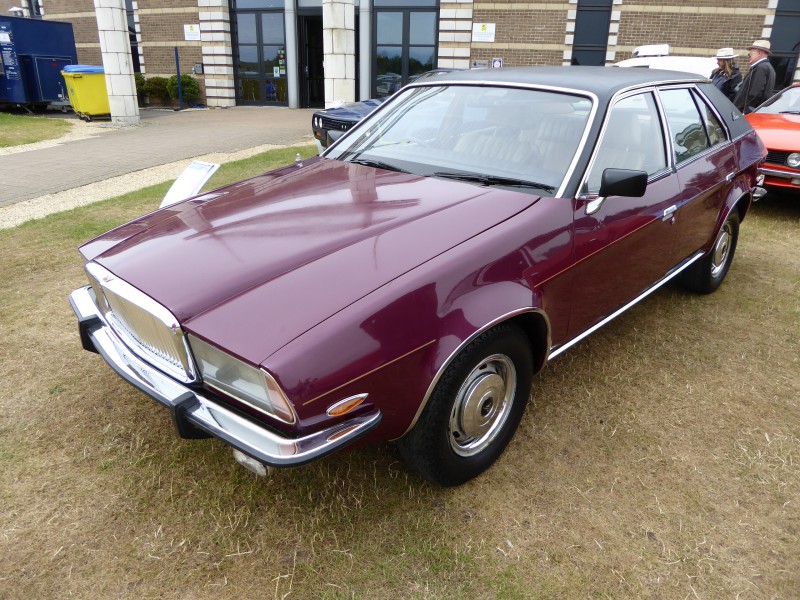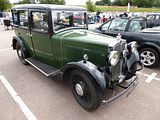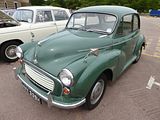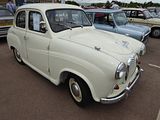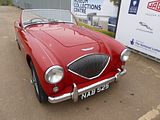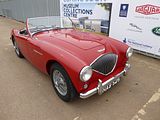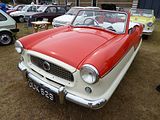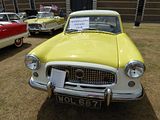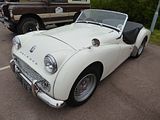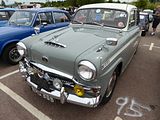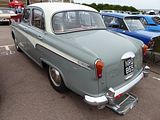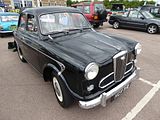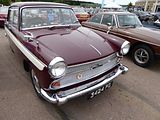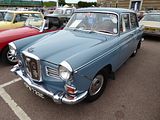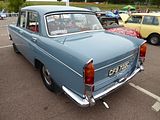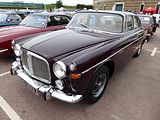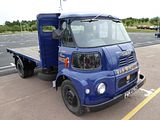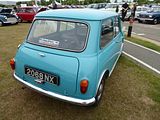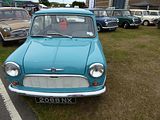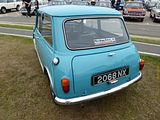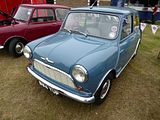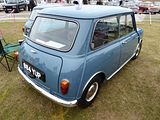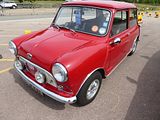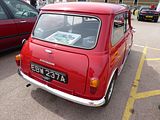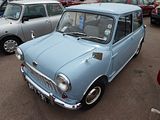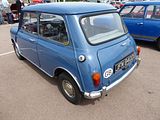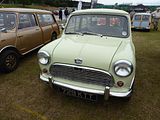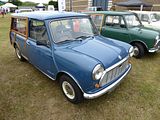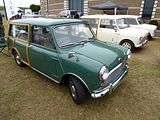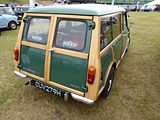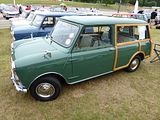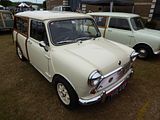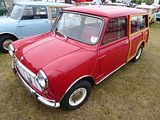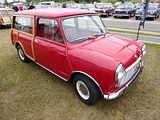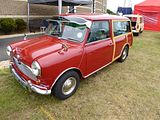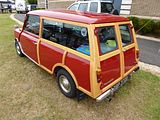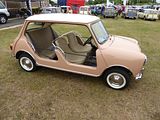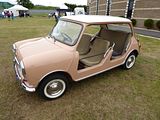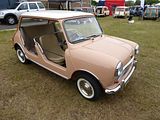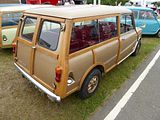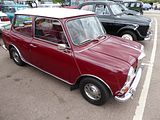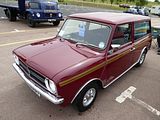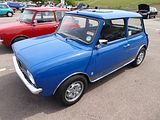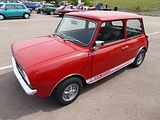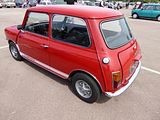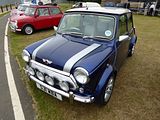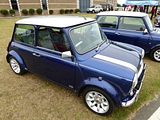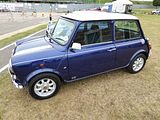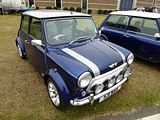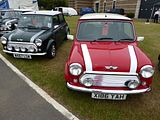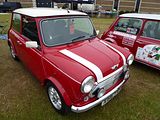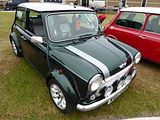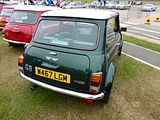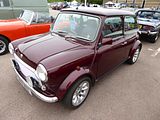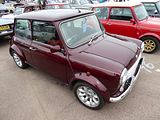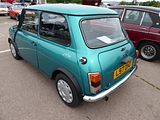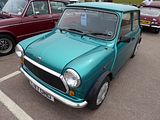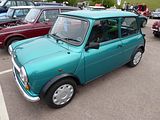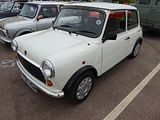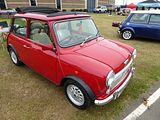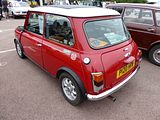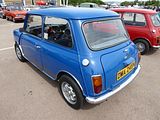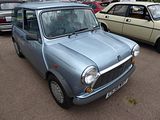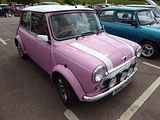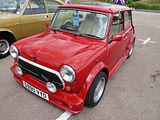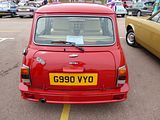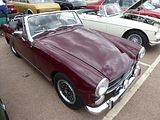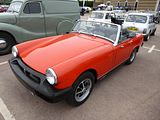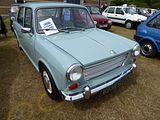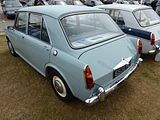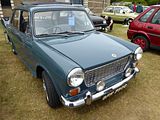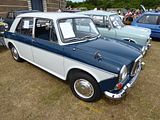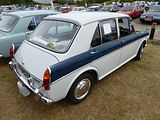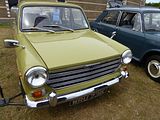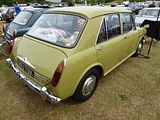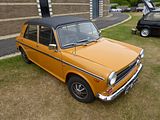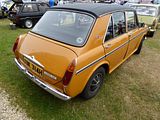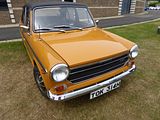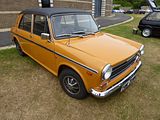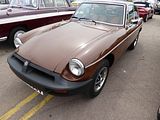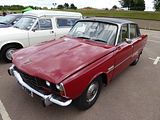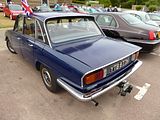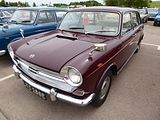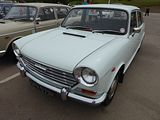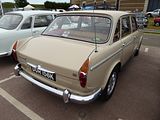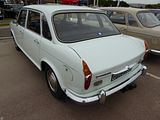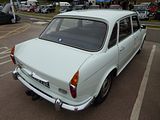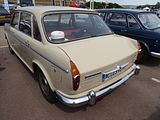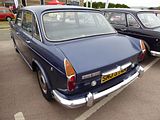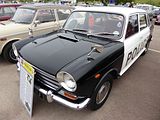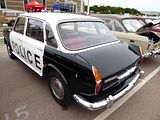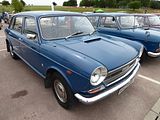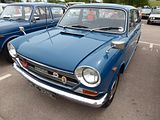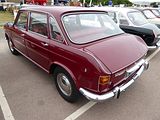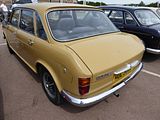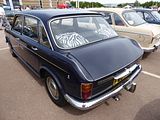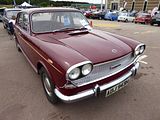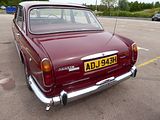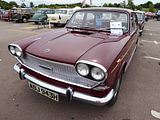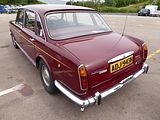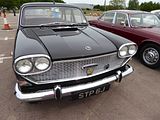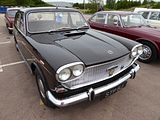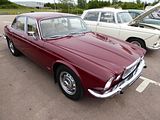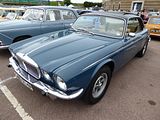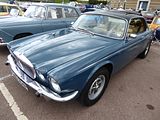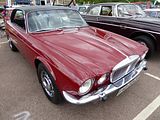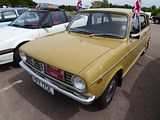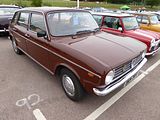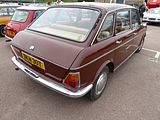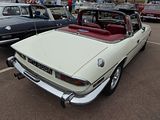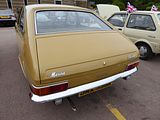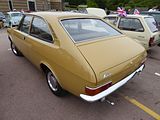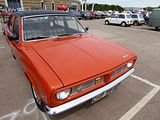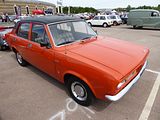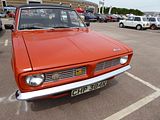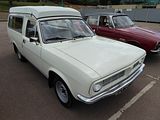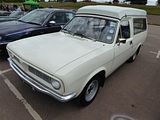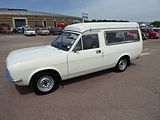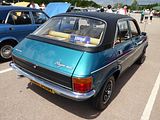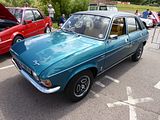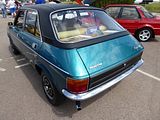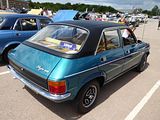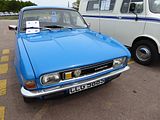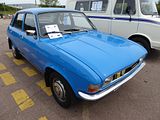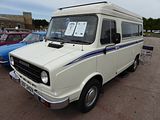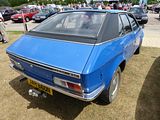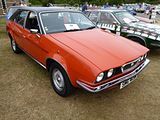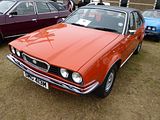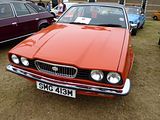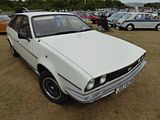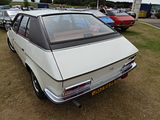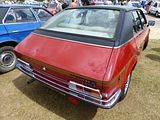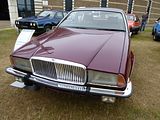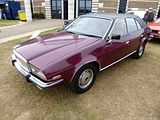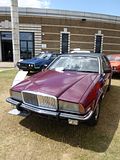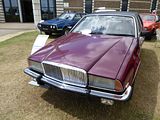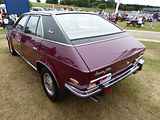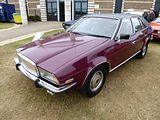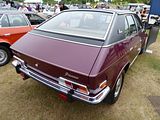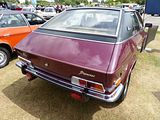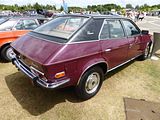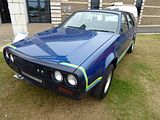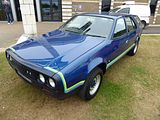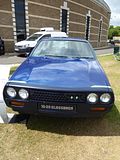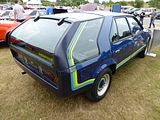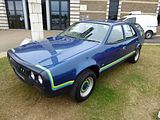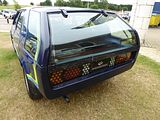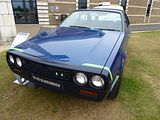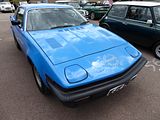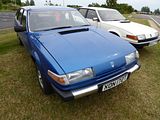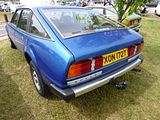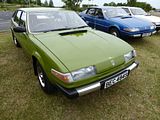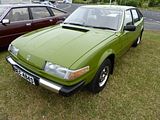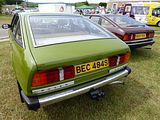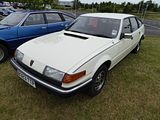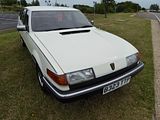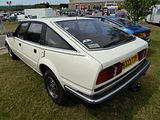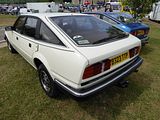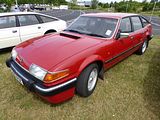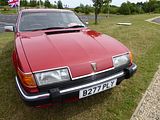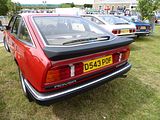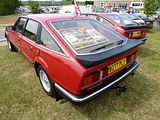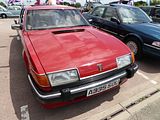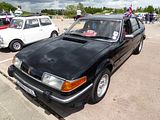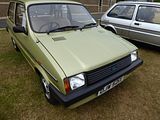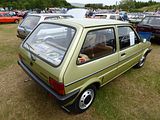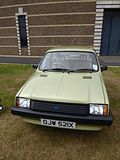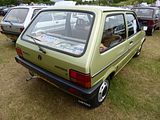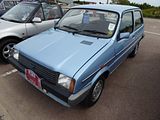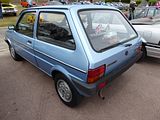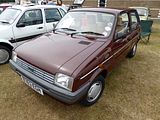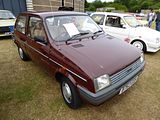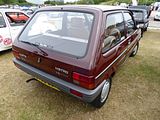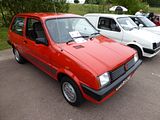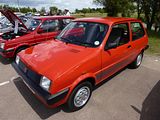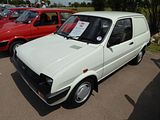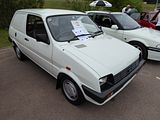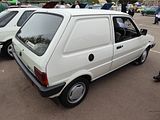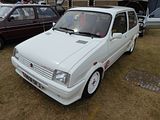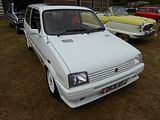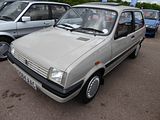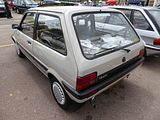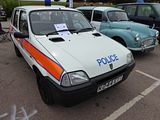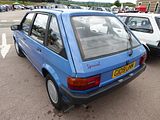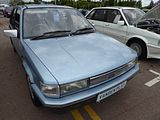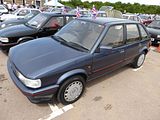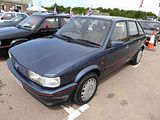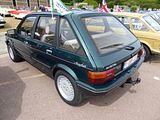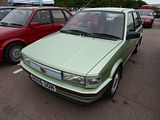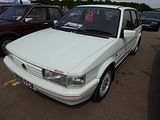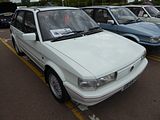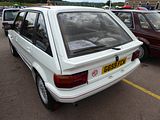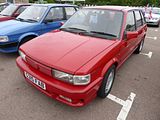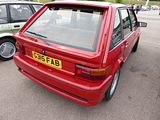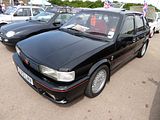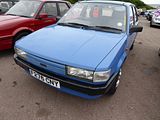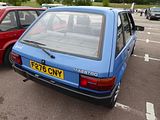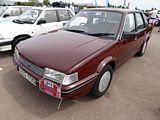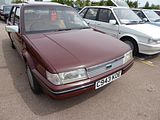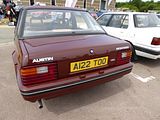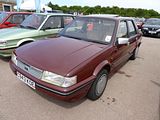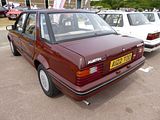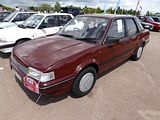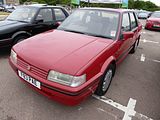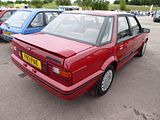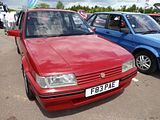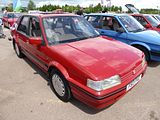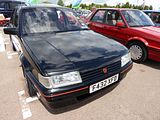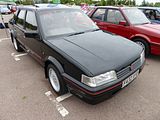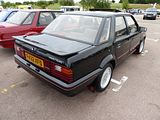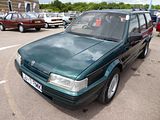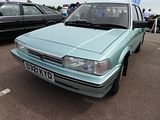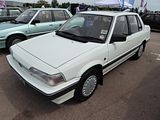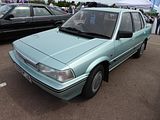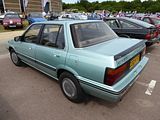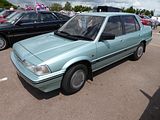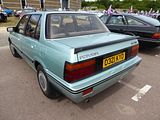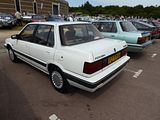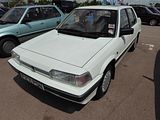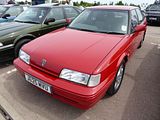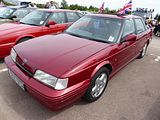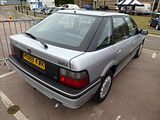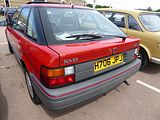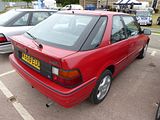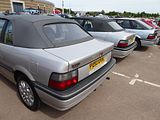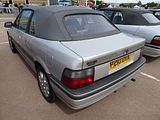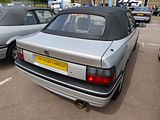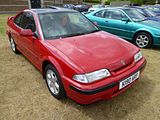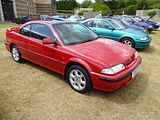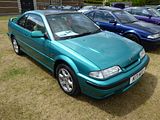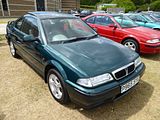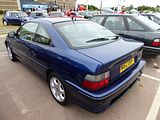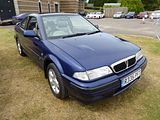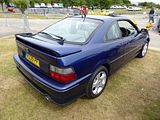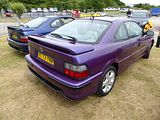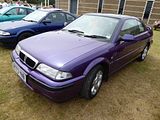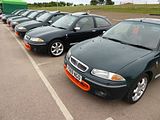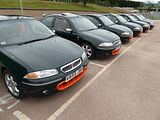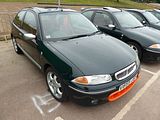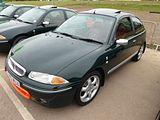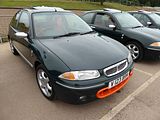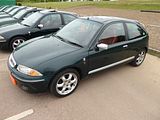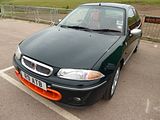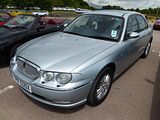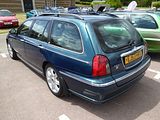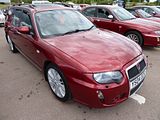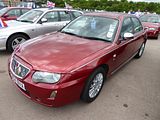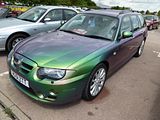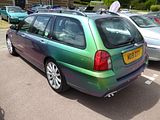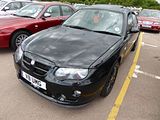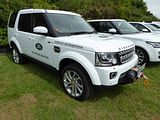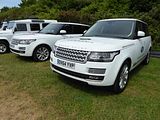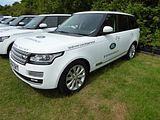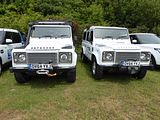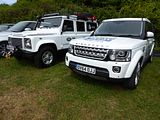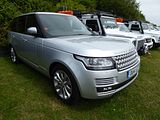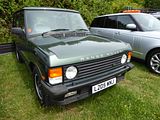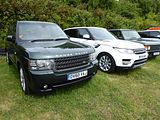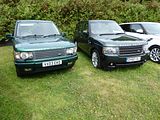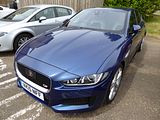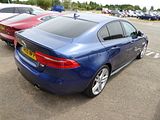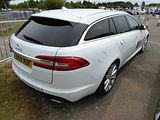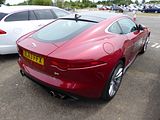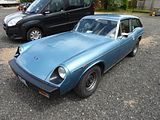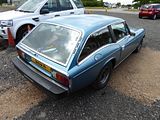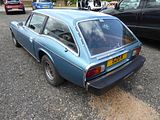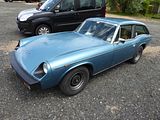It is now more than 10 years since the collapse of the MG-Rover organisation, as the final incarnation of an automotive conglomerate also variously called BMC, British Leyland, BL Cars, Austin-Rover, Rover Group as well as by all the various individual brands that were acquired right from the foundation of the Nuffield organisation in the 1930s. 10 years is quite a long time, and yet to prove how long automotive memories can be, and how perceptions linger, you still hear people telling jokes about Britain’s last remaining large-scale car company, poking fun at the cars, the build quality and even their desirability, or, rather the lack of it. And yet, there are plenty of people who see this once mighty concern that used to dominate our domestic car market and provide employment for tens of thousands of people, through some far more nostalgic and affectionate eyes. There are Owners Clubs for not just every single brand that was ever part of the whole, but for many of the individual models as well, which do much to keep the memory alive, and many of these combine forces to join in events throughout the year to mark the whole of let’s call it British Leyland, its history and its cars. One of them takes place at Cofton Park, across the road from the old Austin factory in Longbridge in mid April on the Saturday nearest to the date when the company went out of business in 2005, and I’ve been to this every year since 2011 and been amazed at the sheer quantity of cars that turn up in celebration of Britain’s motoring heritage. This year I managed to include another BL gathering into my busy schedule, by visiting the Gaydon Museum, home of many historic BL production models and prototypes, for their annual BL Day, which takes place at the start of July. The event publicity, and indeed photos from the event from previous years suggested that this is also a well-attended gathering, with several hundred cars likely to turn up, and a few rarities are always pulled out from the Gaydon Collection (often from the reserve part that is not on public view), so I was eager to experience it for myself. Sure enough, when I arrived on site, there were already large groupings of cars parked up, arranged by model type, and more continued pour down the long approach drive almost all morning. It made for a fascinating reminder of some of the cars which used to be staples of the British motoring scene, as well as some less commonly seen cars, and true to the promise, there were a couple of surprises extricated from the Museum. The cars that I saw are presented here in chronological order of the introduction of the first model, rather than by marque, as of course many of the models wore Austin, Morris or some other branding almost incidentally compared to the model name itself.
MORRIS TEN
Oldest vehicle on show, and the only pre-war car was this rather splendid 1934 Morris Ten-Four. Announced on 1 September 1932, this was a medium-sized car introduced for 1933 as the company’s offering in the important 10 hp sector of the British market. It continued through a series of variants until October 1948 when along with Morris’ Twelve and Fourteen it was replaced by the 13.5 hp Morris Oxford MO. The Ten was powered by a Morris 1292 cc four-cylinder side-valve engine employing a single SU carburettor which produced 24 bhp at 3,200 rpm. The gearbox was a four-speed manual transmission unit, and Lockheed hydraulic brakes were fitted. At launch, available bodystyles were restricted to a saloon and two door coupé but a four door tourer joined the range in December followed in 1934 by a two-seater with dickey seat and a Traveller’s Saloon. On 28 August 1933 a 12 hp six-cylinder version of the Ten, with a slightly larger 1378cc engine, was announced on the longer-wheelbase chassis of the Cowley Four. With the introduction of the Ten Six, Four was added to the regular Ten’s name. The chassis was strengthened, engine mountings were revised and synchromesh appeared on the gearbox. Engine output was increased to 27½ bhp by April 1934. Two tone paint schemes were optional from 1935. A sporting version, the Ten-Six Special was also made in small numbers with tuned engine and twin SU carburettors. The standard body for this version was an open four-seater, but some chassis were supplied to coachbuilders. Just under 50,000 Morris Tens were sold before a Series 2 car was introduced in 1935.
AUSTIN A40
The first all new product from Austin after the war was the A40, which was launched in 1947, as the Dorset (a two door) and Devon (four door saloon). Taking some of their componentry from the pre-war Austin Eight, there was much that was all new in these cars, and sales of the Devon were strong, mostly in export markets. A range of light commercial versions were offered as well, the GV2 Panel Van, GQU2 Pickup and GK Countryman Estate car. The very early GV2 vans, introduced soon after the Devon and the Dorset were obviously based on the saloon, but in fact shared only some parts with it. The doors were the same pressings, although had different interior and exterior trim. The front end panelwork was derived from the saloon, although the front wings had larger apertures to accommodate the 17″ van wheels. The wheels were also much sturdier in design when compared to the 16″ rims fitted to the saloon. The rear bodywork was formed in aluminium, and there was a fabric centre panel in the roof. Removable rear spats covered the rear wheels, a feature shared with the pickup and van-based Countryman estate car. The grille was the mazak/chrome item found on the saloon, and the chassis and running gear, with its hydra-mechanical braking arrangement, were also shared (albeit with revised gear ratios). Early vans and cars had 5″ headlamps, but this would soon switch to Lucas 7″ units, and separate sidelights. At first glance, the A40 van seemed to change little throughout its production, a run that continued long after the contemporary Devon and Somerset saloons ceased, but in detail barely a year went by without some change being introduced by BMC, to improve the van and maintain its competitiveness. It was early in 1951 when the first batch of obvious changes were made. Most evident was a switch to a new grille assembly, painted instead of chrome. Early vans had smooth bonnets, although due to issues with cooling, extra vents were soon let in to the leading edge of the bonnet. By now the rear bodywork was in steel, including the roof panel, but still featuring separate aluminium rear wheel spats. The switch from the Devon-style dashboard to a simpler painted dash also occurred at around this time. These vans were known as the GV3 series. Late in 1951 the Devon saloon underwent a number of revisions, including a switch to a column gearchange, and hydraulic braking to all four wheels. The 17″ wheels were modified slightly, to accommodate wider brake drums, meaning that wheels for earlier vans are not interchangeable with later examples. The revised GV4 commercials followed many of the changes introduced to the saloon, in preparation for the introduction of the Somerset-type running gear due in 1952. This would be the year that the A40 Devon saloon was replaced, yet the light commercials remained in production, alongside the Somerset saloon, for many years to come. By 1953 the A40’s rear bodywork would see another update, this time integrating the rear arches into the main body of the vehicle, at the same time improving access for wheel changing. The final GV5 series van, introduced in September 1954, continued in production, alongside the new A40/A50 Cambridges, right up to 1957, meaning that the A40 vans stayed in production for ten years. Over 78,000 vans were produced, as well as 61,800 pickups and 26,500 Countryman estates. As with all light commercials, these 1/2 ton vans usually got a real hammering in the hands of the many different tradesmen that bought the 10cwt Austin van. As a result, survivors are distinctly rare on the ground, so it was nice to see this well presented example.
MORRIS MINOR
With an H plate on it, this is one of the last Minor saloons. Issigonis’ first design was first launched in 1948, and it quickly found success, even if Lord Nuffield did declare that the car looked like a poached egg!. Not only was the car popular when new, so much so that various attempts at designing a replacement ended up with the Minor outlasting them, but it was one of the first “old” cars that people in the late 70s decided were worth spending money to refurbish as opposed to scrapping them, helping to sow the seeds of what we now call the Classic Car sector.
AUSTIN A30/35
The Morris Minor was already well established when rival Austin launched their competitor, the A30 Saloon of 1952. That was also the year that Austin and Morris merged to become the British Motor Corporation, so suddenly the two cars that had been conceived to compete against each other were stablemates. Except BMC did not work like that. Separate dealer chains remained in place, as they would do for a further 30 years, and whilst this may sound inefficient now, it has to be noted that brand loyalty was such that there were plenty of people would only consider an Austin say, and not a Morris, or vice versa. The A30 was smaller than the Minor and at £507, at launch, it was also £60 cheaper. The body structure was designed by T.K. Garrett, who had been an aeronautical engineer before joining Austin. It was of fully stressed monocoque chassis-less construction, which made it lighter and stiffer than most contemporary vehicles, the first Austin to be made in this way. Inside there were individual seats at the front and a bench at the rear covered in PVC with an option of leather facings on the seats. Evidence of economy was seen in only having a single windscreen wiper, central combined stop/tail/numberplate lamp and a sun visor in front of the driver only. A passenger-side wiper and sun visor, and a heater were available as optional extras. Even so, it sold well, and 223,264 examples were built. The A30 was replaced by the Austin A35 in 1956 with the new name reflecting the larger and more powerful 34 hp A-Series engine, which gave the car a slightly higher top speed and better acceleration, though much of this came as a result of different gearbox ratios. The A30 had the first three ratios close together then a big gap to top, whereas in the A35, the ratios were better spaced and gave a higher speed in third gear. That top speed was 72 mph and 0 – 60 acceleration times are just over 30 seconds, so this remains a very slow car by modern standards. The A35 was very similar in appearance to the A30, and is best recognised by its larger rear window aperture and a painted front grille, with chrome horse-shoe surround, instead of the chrome grille featured on the A30. The semaphore trafficators were replaced with present-day front- and rear-mounted flashing light indicators. A slightly easier to operate remote-control gear-change was provided. Like the A30, the A35 was offered as a two- or four-door saloon or two-door “Countryman” estate and also as a van. The latter model continued in production through to 1968. A rare coupe utility (pickup) version was also produced in 1956, with just 477 sold. Drawings were made for a sports tourer, but no prototype was actually built. The A35 passenger cars were replaced by the new body shape A40 Farina models in 1959 but the estate car version continued until 1962 and van until 1968. These days they are popular as an affordable classic. Their simple mechanicals, good availability of some parts (not bodywork, though) and pert looks give them widespread appeal. There was a neat example of a 4 door A35 here.
AUSTIN-HEALEY 100/3000
Donald Healey had been producing a range of expensive sports cars from the 1940s, cars such as the Silverstone, the Abbott and the Farnham. For the 1952 London Motor Show, he produced a new design, which was called the Healey Hundred, based on Austin A90 mechanicals, which he intended to produce in-house at his small car company in Warwick. It was one of the stars of the 1952 Show, and it so impressed Leonard Lord, the Managing Director of Austin, who was looking for a replacement to the unsuccessful A90. that Lord struck a deal with Healey on the spot, to build it in quantity. Bodies made by Jensen Motors would be given Austin mechanical components at Austin’s Longbridge factory. The car was renamed the Austin-Healey 100, in reference to the fact that the car had a top speed of 100 mph. Production got under way in 1953, with Austin-Healey 100s being finished at Austin’s Longbridge plant alongside the A90 and based on fully trimmed and painted body/chassis units produced by Jensen in West Bromwich—in an arrangement the two companies previously had explored with the Austin A40 Sports. By early 1956, production was running at 200 cars a month, 150 of which were being sold in California. Between 1953 and 1956, 14,634 Austin-Healey 100s were produced, the vast majority of them, as was the case for most cars in this post war era, going for export. The car was replaced by an updated model in 1956, called the 100-6. It had a longer wheelbase, redesigned bodywork with an oval shaped grille, a fixed windscreen and two occasional seats added (which in 1958 became an option with the introduction of the two-seat BN6 produced in parallel with the 2+2 BN4), and the engine was replaced by one based on the six-cylinder BMC C-Series engine. In 1959, the engine capacity was increased from 2.6 to 2.9 litres and the car renamed the Austin-Healey 3000. Both 2-seat and 2+2 variants were offered. It continued in this form until production ceased in late 1967. The Big Healey, as the car became known after the 1958 launch of the much smaller Austin-Healey Sprite, is a popular classic now. You come across the 3000 models more frequently than the 100s, as they accounted for more than 60% of all Big Healey production, so it was nice to see an example of the latter here.
METROPOLITAN
There was a little slice of 50s Americana here with a pair of brightly coloured Metropolitans. Designed in the U.S. and patterned from a concept car, the NXI (Nash Experimental International), that was built by Detroit-based independent designer William J. Flajole for Nash-Kelvinator, this was designed as the second car in a two car family, for “Mom taking the kids to school or shopping or for Dad to drive to the railroad station to ride to work”, this “commuter/shopping car” bore a resemblance to the big Nash models of the era, but the scale was tiny as the Met’s wheelbase was shorter than a Volkswagen Beetle’s. The NXI design study had incorporated many innovative features, and attempted to make use of interchangeable front and rear components (the symmetrical door skins were the only interchangeable items that made it into production). Although more complex, the new vehicle also incorporated Nash’s advanced single-unit monocoque construction. It had been displayed at a number of “surviews” (survey/previews), commencing on 4 January 1950 at the Waldorf-Astoria Hotel, New York, to gauge the reaction of the American motoring public to a car of this size, the results of which convinced Nash that there was indeed a market for such a car, if it could be built at a competitive price. A series of prototypes followed that incorporated many of the improvements requested, including roll-up glass side windows, a more powerful engine, and a column-mounted gearlever with bench seat (rather than bucket-type seats with floor change of the concept car). The model was named NKI (for Nash-Kelvinator International), and it featured revised styling incorporating a hood blister and rear wheel cutouts. Nash was positioning this new product for the emerging postwar market for “personal use” autos, and also saw it as a means of Nash to overseas markets. However, Mason and Nash management calculated that it would not be viable to build such a car from scratch in the U.S. because the tooling costs would have been prohibitive. The only cost-effective option was to build overseas using existing mechanical components (engine, transmission, rear end, suspension, brakes, electrical), leaving only the tooling cost for body panels and other unique components. Nash Motors negotiated with several European companies, and on October 5, 1952, announced that they had selected the Austin Motor Company (by then part of BMC) and Fisher & Ludlow (which also became part of BMC in September 1953, later operating under the name Pressed Steel Fisher), both based in Birmingham and vicinity. Fisher & Ludlow would produce the bodywork, while the mechanicals would be provided, as well as final assembly undertaken, by the Austin Motor Company. This was the first time an American-designed car, to be exclusively marketed in North America, had been entirely built in Europe. It became a captive import – a foreign-built vehicle sold and serviced by Nash (and later by American Motors) through its dealer distribution system. It is believed that the first pre-production prototype was completed by Austin on December 2, 1952. In all, five pre-production prototypes were built by Austin Motors and tested prior to the start of production. The total tooling cost amounted to US$1,018,475.94, which was a fraction of the tooling cost for a totally U.S.-built vehicle. The styling for all Nash vehicles at that time was an amalgam of designs from Pininfarina of Italy and the in-house Nash design team. The different models from Ambassador down to the Metropolitan utilised very similar design features (fully enclosed front wheels, notched “pillow” style door pressing, bar style grille etc.). Whilst Nash used the fact that styling was by Pininfarina in their advertising for their larger models, Pininfarina refused to allow his name to be associated with the Metropolitan as he felt it would damage his reputation with other Italian car companies to be linked to such a small car. The new Metropolitan was made in two body designs: convertible and hardtop. All came with several standard features that were optional on most cars of the era. Among these factory-installed benefits for customers were a map light, electric wipers, a cigar lighter, and even a “continental-type” rear-mounted spare tyre with cover. To give a “luxury” image to the interior, “Bedford cord” upholstery trimmed with leather was used (similar to larger Nash vehicles). An AM radio, “Weather Eye” heater, and whitewall tyres were offered as optional extras for the U.S. market. (It is unlikely that a Metropolitan could have been purchased without a heater and radio, as all vehicles left the factory with both items fitted.) The cars were small, with an 85 in wheelbase, an overall length of just 149.5 in and a gross weight of only 1,785 lb for the Convertible and 1,825 lb for the Hardtop, thus making the Metropolitan smaller than the Volkswagen Beetle. Power came from an OHV 1,200 cc straight-4 Austin ‘A40′ series engine as used in the Austin A40 Devon/Dorset) driving the rear wheels through a three-speed manual transmission. The new model was initially to be called the “NKI Custom”, but the name was changed to “Metropolitan” just two months before its public release. New chrome nameplates with the “Metropolitan” name were made to fit into the same holes as the “NKI Custom” script on the passenger side front fender. Nash dealers had to rebadge the early cars that came with the “NKI Custom” name, but some factory manuals had already been prepared and distributed to service departments with the NKI name. Initial reviews of the Metropolitan were mixed. However, owners of the cars reported that the “Metropolitan is a good thing in a small package”. Automotive industry veteran and the largest publisher of automotive books at the time, Floyd Clymer, took several Metropolitans through his tests. He “abused” a 1954 Metropolitan convertible and “got the surprise of my life” with its “performance was far better than I expected”, that he “felt very safe in the car”, and that “it may well be that Nash has started a new trend in American motoring. Perhaps the public is now getting ready to accept a small car”. Clymer also took a 1957 Metropolitan hardtop through a gruelling 2,912 mi road test that even took him 14,100 ft up Pikes Peak. He summed up his experience that “I can not praise the Metropolitan too highly. It is a fascinating little car to drive, its performance is far better than one would expect, and the ride is likewise more than expected”. It was not all good, of course, with Motor Trend magazine describing the backseat as “a joke”. Performance, whilst pedestrian by today’s standards, with a 0 to 60 mph time over 19.3 seconds and a top speed in excess of 70 mph was far better that of the rival VW, but at 60 mph, a common American cruising speed at the time, the Metropolitan was revving at 4300 rpm, which shortened engine life, whereas the Volkswagen could travel at the same speed at only 3000 rpm. Road & Track ’s testers also said that the car had “more than its share of roll and wallow on corners” and there was “little seat-of-the-pants security when the rear end takes its time getting back in line.” The lack of any form of opening for the boot also attracted plenty of complaints. Production at Austin’s Longbridge factory started in October 1953. The initial order was for 10,000 units, with an option to increase the order if sales were sufficient. The first examples badged as Nash went on sale on March 19, 1954 in the U.S. and Canada. Autocar said that “at a production rate of less than 400 cars a week … it was hardly going to be a runaway best seller.” In surveys, Americans had affirmed a desire for economy cars, but in practice they bought the Metropolitan in relatively small numbers. Although Nash merged with Hudson in 1954, and marketed the car as a Hudson Metropolitan in 1955, “demand never took off from the original level”, primarily because the Metropolitan was slow by North American standards. In the first month of sales, 862 Metropolitans were sold in U.S. and Canada, while in the first six months a total of 7,042 were sold. A further order was placed with Austin. After the first 10,000 cars were built, the engine was changed to a B-Series, but still of 1,200 cc, as used in the Austin A40 Cambridge. Other modifications that were incorporated at this time were a new gearbox, and hydraulic actuation for the clutch. The change to a new engine and gearbox added 50 lb to the weight. November 1955 saw the start of Metropolitan Series III (NK3) production. A redesign at this time saw the Metropolitan’s B-Series engine increased in capacity to 1,498 cc, as used in the Austin A50 Cambridge. Polished stainless steel sweep-spears on the body sides allowed a new two-tone finish to be incorporated, which had the cosmetic effect of lowering, slimming and lengthening the car. The grille was also redesigned, and the bonnet had its non-functional hood scoop removed. American Motors changed the designation to “Metropolitan 1500” to differentiate it from the earlier 1,200 cc models. The interior was also changed to incorporate a “houndstooth” check material for the seats trimmed with white vinyl. The dashboard was also now painted black, rather than the body color as was the case for Series I and II Metropolitans. In September 1957, AMC announced that it was dropping the Nash and Hudson brand names. The Metropolitan was subsequently marketed under the “Metropolitan” name only, and sold through Rambler dealers. January 1959 saw the start of Metropolitan Series IV (NK4) production. This major redesign saw the addition of an external bootlid, at last. By this time, the engine had been upgraded by increasing the compression ratio from 7.2:1 to 8.3:1 giving an output of 55 bhp, as used in the Austin A55 Cambridge). The additional features added 15 lb (6.8 kg) to the weight. Sales rose to 22,209 units in 1959, the Metropolitan’s best-selling year, promoting it to second place behind Volkswagen in sales of cars imported to the U.S. American Motors’ advertising made much of this ranking, while omitting mention that the Volkswagen outsold the Metropolitan by 5½ to 1. Production ceased in April 1961, though sales of the existing inventory continued until March 1962. Approximately 95,000 Metropolitans were sold in the United States and Canada, making it one of the top-selling cars to be imported into those countries at the time, and its sales in 1959 helped to spur the introduction of the Big Three’s (General Motors, Ford, and Chrysler) new compact models. In October 1956, Austin obtained permission from American Motors to sell the Metropolitans in overseas countries where AMC did not have a presence. The early brochures for the Austin Metropolitans used a reversed photograph to show an apparently right hand drive (RHD) car parked in an English country town because only left hand drive vehicles were available at the time the photos were taken. From December 1956, production of Austin Metropolitans began, and from April 2, 1957, approximately 9,400 additional units were sold in overseas markets that included the United Kingdom. List prices for the UK Series III models were £713 17s 0d for the Hardtop and £725 2s 0d for the Convertible. An estimated 1,200 Metropolitans were sold in the UK in four years, though some have claimed far more than this were sold here. Markedly American, the styling was considered outlandish compared with the more sober British-styled models in the British Motor Corporation lineup. Only Series III and Series IV Metropolitans were produced for sale in the UK. UK Series III sales ran from April 1957 to February 1959. Series IV models, were sold from September 1960 to February 1961. The Metropolitan was not available for UK sales between February 1959 and September 1960, since all production during that time was for US & Canadian dealers. When sales in the UK resumed they were sold through Austin dealers at listed prices of £707 6s 8d for the Hardtop and £732 2s 6d for the Convertible. Austin was dropped from the name, which now became simply “Metropolitan”, and the cars carried no Austin badges although they had Austin Company chassis plates. Despite this the car remained known, by trade and public alike, as the Austin Metropolitan. In May 1960, Car Mart Ltd. (a large Austin dealership in London) presented Princess Margaret with a specially prepared Metropolitan finished in black with gold trim and gold leather interior as a wedding present. It was stolen in London in February 1961.
TRIUMPH TR3
Oldest example of the popular and long running Triumph TR series here was a TR3a. Introduced in 1955, the TR3 was an evolution of the TR2 and not a brand new model. It was powered by a 1991 cc straight-4 OHV engine initially producing 95 bhp, an increase of 5 hp over the TR2 thanks to the larger SU-H6 carburettors fitted. This was later increased to 100 bhp at 5000 rpm by the addition of a “high port” cylinder head and enlarged manifold. The four-speed manual gearbox could be supplemented by an overdrive unit on the top three ratios, electrically operated and controlled by a switch on the dashboard. In 1956 the front brakes were changed from drums to discs, the TR3 thus becoming the first British series production car to be so fitted. The TR3 was updated in 1957, with various changes of which the full width radiator grille is the easiest recognition point and this facelifted model is commonly referred to as the Triumph “TR3A”, though unlike the later TR4 series, where the “A” suffix was adopted, the cars were not badged as such and the “TR3A” name was not used officially, Other updates included exterior door handles, a lockable boot handle and the car came with a full tool kit as standard (this was an option on the TR3). The total production run of the “TR3A” was 58,236. This makes it the third best-selling TR after the TR6 and TR7. The TR3A was so successful that the original panel moulds eventually wore out and had to be replaced. In 1959 a slightly modified version came out that had raised stampings under the bonnet and boot hinges and under the door handles, as well as a redesigned rear floor section. In addition, the windscreen was attached with bolts rather than the Dzus connectors used on the early “A” models. It is estimated that only 9,500 of the original 58,000 built survive in the world today.
AUSTIN A95/105 WESTMINSTER
Austin introduced 2 new models at the 1954 London Motor Show, the family-sized A40/A50 Cambridge saloon and a more costly and more powerful A90 Westminster. This latter used the new BMC C-Series straight-6 engine with single Zenith carburettor and its 2639 cc produced 85 hp which gave a top speed of 85.7 mph and acceleration from 0–60 mph in 18.9 seconds and a fuel consumption of 20.2 mpg. There was independent front suspension using coil springs and wishbones and leaf spring and anti-roll bar on the live axle at the rear. The four-speed transmission had synchromesh on the top three ratios and from 1955 an overdrive unit could be specified. The interior, with leather trim on the de luxe version and PVC on the standard model, had a split bench front seat arrangement, although individually adjustable, which if necessary could seat three people abreast. When only two were carried there were, on the de luxe model, fold down centre armrests at the side of each seat. The de luxe model also had a central fold down armrest in the rear. The handbrake was under the dash on the right hand side of the steering column which also carried the gear lever. A heater was standard on the de luxe model but optional on the standard version. In May 1956, for a brief period only, a derivative of the A90 Six Westminster was announced which was a short boot version of the A105 and had the twin SU carburettor/102 hp version of the 2.6-litre C series engine with overdrive as standard. In October 1956 the A105 received the longer wheelbase with overdrive as standard and automatic transmission as an option. Twin fog lights heater and wheeltrims were standard although a radio was still an option. Twotone paint and white-wall tyres were introduced for visual effect. Very few short boot versions of the A105 were produced and they are now quite rare. The A90 was updated for autumn 1956 as the A95. Along with more power, the A95 was longer and now offered an estate model. Overdrive and an automatic transmission were new as well, something of a novelty in British cars of the time. The Westminster name was dropped from the sales literature for the A95 and the A105 although, oddly, the drivers’ handbooks still used the name Westminster to title the illustration of the saloon. The estate version was titled Countryman. Nevertheless, most enthusiasts still refer to them as Westminsters. Both the A95 and A105 were produced together until 1959. 28,065 A95s and 6,770 A105s were built. Seen here is an A105 dating from 1957.
WOLSELEY 1500
The Wolseley 1500 is one of a pair of medium sized saloon cars, the Riley One Point Five being the other, which was launched in 1957. Conceived as a potential replacement for the Morris Minor, because that car was still selling well, the model ended up only ever being offered with the more costly marques’ badges attached (though Australians did get variants called the Austin Lancer and Morris Major). The Riley and similar Wolseley were based on the Morris Minor floorpan, suspension and steering but fitted with the larger 1489 cc B-Series engine and MG Magnette gearbox. As well as trim and badging, the twins were differentiated by nearly 20 hp, the more sporting Riley having twin SU carburettors giving it the most power at 68 hp. The Wolseley was released first, in April, while the Riley appeared in November, directly after the 1957 London Motor Show. A Series II model came out in May 1960. The most notable external difference was the hidden boot and bonnet hinges. Interior storage was improved with the fitting of a full width parcel shelf directly beneath the fascia. The Series III launched in October 1961, featuring revisions to the grille and rear lights. In October 1962 the car received the more robust crank, bearing and other details of the larger 1,622 cc unit now being fitted in the Austin Cambridge and its “Farina” styled clones. Unlike the Farina models, however, the Wolseley 1500 and Riley One-Point-Five retained the 1,489 cc engine size with which they had been launched back in 1957. Production ended in 1965 with 39,568 Rileys and 103,394 Wolseleys made.
FARINA SALOONS
By the mid 1950s, the BMC organisation was well established, and it dominated the UK market with a 39% share. Plans were made for a complete new range of cars that would encompass all the marques: Austin, Morris, MG, Riley and Wolseley. Italian stylist Pininfarina was commissioned to design them. The first model to appear was the A40, launched early in 1958. There were no examples of that model here, but there were several of the range that followed. which are often referred to as the Farina Saloons. BMC took the decision to produce a very similar looking model with each of the 5 marque’s badges attached. They were released over a period of months, starting in late 1958 with the Wolseley 15/60. This was followed by the A55 Cambridge Mark II, the Morris Oxford Series V, the MG Magnette Series III and the Riley 4/68. The same basic body style was applied to all, with just trim differences, and in the case of the MG and Riley, more powerful engines thanks to a twin carburettor set up under the bonnet, introducing the world to the concept of “badge engineering”. Whilst the styling was something of an amalgam of Italian glamour and a touch of Americana, with prominent tail fins, under the skin the cars were very conventional. Whilst some may have been disappointed that BMC had not been more adventurous, this was an era when home car maintenance was an established part of the suburban landscape, so simplicity was not completely unwelcome. The familiar 1.5-litre B-Series engine, four-speed manual and straightforward rear-wheel drive gave it solid appeal to many middle-class buyers, especially those horrified by the black magic of the newly launched front-drive Mini. All 5 cars were four-door saloons, with estate versions offered of the Austin and Morris. A facelift was applied to them all in late 1961, when the tail fins were toned down and an enlarged 1622cc B Series engine found its way under the bonnet, with more power, new names came in for the Wolseley which became the 16/60 and the Austin which adopted the A60 Cambridge name. It was this duo which were represented here.
ROVER P5
Beloved of Government Ministers, who kept the car in service long after production had ceased in 1973, thanks to an amount of stock-piling, and now a much loved classic, the P5 is a quintessentially British motor car. Launched in late 1958, it was a partial replacement for the then 10 year old P4 model, but also an extension of the Rover range further upmarket. Early cars were known as the 3 litre, as they had It was powered by a 2,995 cc straight-6 engine which used an overhead intake valve and side exhaust valve, an unusual arrangement inherited from the Rover P4. In this form, output of 115 bhp was claimed. An automatic transmission, overdrive on the manual, and Burman power steering were optional with overdrive becoming standard from May 1960. Stopping power came originally from a Girling brake system that employed 11″drums all round,but this was a heavy car and by the time of the London Motor Show in October 1959 Girling front-wheel power discs brakes had appeared on the front wheels. The suspension was independent at the front using wishbones and torsion bars and at the rear had a live axle with semi-elliptic leaf springs. A Mark I-A line, introduced in September 1961, featured a minor restyle with added front quarter windows, intended to “assist the dashboard ventilation”. Under the skin, the 1A featured modifications to the engine mountings and the automatic transmission and hydrosteer variable ratio power steering as an option. By 1962, when production of the original Mark I series ended, 20,963 had been produced. The Mark II version was introduced in 1962. It featured more power,129 hp, from the same 3 litre engine and an improved suspension, while dropping the glass wind deflectors from the top of the window openings which also, on the front doors, now featured “quarterlight” windows. The most notable addition to the range was the option of the Coupé body style launched in autumn 1962. Unlike most coupés, which tend to be two-door versions of four-door saloons, this retained the four doors and was of the same width and length as the saloon, but featured a roofline lowered by two and a half inches along with thinner b-pillars, giving it the look of a hardtop. Hydrosteer was standard on the Coupe and optional on the Saloon. Production of the Mark II ended in 1965, by which time 5,482 coupés and 15,676 saloons had been produced. The Mark III was presented at the London Motor Show in October 1965, described at the time as “even more luxuriously trimmed and furnished”. It was again available in two 4-door body styles, coupé and saloon. The Mark III used the same engine as its predecessor, but it now produced 134 hp. Externally it could be distinguished by the full-length trim strip along the body and Mark III badging; internally it replaced the rear bench seat with two individually moulded rear seats, making it more comfortable to ride in for four occupants but less so for five. A total of 3,919 saloons and 2,501 coupés had been sold by the time production ended in 1967. The final iteration of the P5 appeared in September 1967. Now powered by the 3,528 cc Rover V8 engine also used in the P6 model 3500, the car was badged as the “3.5 Litre”, and commonly known as the 3½ Litre. The final letter in the “P5B” model name came from Buick, the engine’s originator. Rover did not have the budget or time to develop such engines, hence they chose to redevelop the lightweight aluminium concept Buick could not make successful. They made it considerably stronger, which added some weight but still maintained the engine’s light and compact features. The Borg Warner Type-35 automatic transmission, hydrosteer variable ratio power steering and front Lucas fog lights were now standard. Output of 160 bhp was claimed along with improved torque. When compared to its predecessor, the aluminium engine enabled the car to offer improved performance and fuel economy resulting both from the greater power and the lesser weight of the power unit. The exterior was mostly unchanged, apart from bold ‘3.5 Litre’ badging, a pair of fog lights which were added below the head lights, creating a striking 4 light array, and the fitting of chrome Rostyle wheels with black painted inserts. The P5B existed as both the 4-door coupe and saloon body style until end of production. Production ended in 1973, by when 9099 coupés and 11,501 saloons had been built. Seen here is a P5B Coupe.
MORRIS FG 550
One of the more distinctive commercial vehicles ever to grace Britain’s roads, this started out life as the Morris FG Series, and was launched in 1960. Later it was also sold as the Austin S200 and 404, and it was renamed the BMC FG in 1968. The name changed again in 1970 when it became the Leyland FG, which was the final branding until production ceased in the early 1980s. The new FG truck burst onto the scene in early 1960, with payload ratings ranging from 1½ tons to 5 tons, it would replace both the LC-series and the lower end of the forward-control FE range. At its launch, the FG’s cab was hailed as a leap forward in commercial vehicle design. Uniquely, the cabin doors were mounted across the angled rear corners of the cab; being rear-hinged and rather narrow, this meant that when opened, they barely protruded beyond the width of the cab itself, thus delivering the main benefit of sliding doors in a context where these clearly could not be used. While BMC coined the term “angle-planned” to describe this arrangement, the FG’s unusual shape soon led users to refer to it as the “three-penny bit”, after the pre-decimal, twelve-sided British coin of that name. Another innovative feature of the FG was its curved kerbside-view windows, mounted at the front corners of the cab, below the windscreen. These helped the driver to “place” the truck when parking, and were also an important aid to safety in busy high streets, as they eliminated a traditional blind-spot. However, all was not sweetness and light for the FG’s driver: the “angle-planned” design had a detrimental impact on the internal width of the cab, and consequently, the seats were rather narrow – as were the doors themselves – making life tough for the more portly driver. And assuming that he could get himself seated comfortably, he then had to contend with the heat generated by the engine which shared his cab-space, and get to grips with a gear lever that was thoughtfully mounted right at the rear of the cab. Despite these shortcomings, the FG had a loyal following in the commercial market; the British Gas company was particularly fond of it, but to anyone who grew up in Britain during the 1970s the FG will be immediately identifiable as the archetypal Sunblest baker’s van. Another popular application for the FG was as a laundry van, in which configuration a capacious walk-through body was fitted to the basic chassis/front-end – with sliding doors.
MINI
There’s a separate event dedicated to Mini models of all ages that takes place at Gaydon during the year, when I understand the site is packed out with a mix of both the modern BMW-owned MINI models and vast numbers of the classic Issigonis models. Whilst it was not packed out with them at this event, there were plenty of really nice examples on show, with lots of early cars, which are the ones that are really piquing collectors’ interest (and their wallets, with some very high prices being paid) right now. The first cars were badged as the Morris Mini Minor and Austin Se7en, and it was some time before the formal name was just shortened to Mini. Differences between the two marques were confined to the grille and badges. The early cars were extremely basic, even in the slightly less stripped out de Luxe version, with their sliding windows, cable-pull door releases, no heater, floor mounted starter button and a long wand of a gear lever that came straight from the gearbox with no remote linkage. A better equipped Super model was available for 1963, but even that would seem to lack many of the things which we have long since taken for granted. Even so, sales did soon take off, and BMC were selling all the cars they could make, even if, as Ford figured out when the acquired a car and stripped down, it was reckoned that they were losing money on every one they made. Whilst it is the 1959 models that command the really high prices now, there are not that many of these cars left and so those made in the next few years of production are also proving very collectible, and there were several of these early Minis to look at, and try to imagine just how radical they must have seemed when they were new.
It is often the case that the more utilitarian versions of a model, such as Estate Cars, Vans and Pickups have a lower survival rate than the Saloon or Sporting models, as these cars tend to have a far harder life right from initial registration, and that’s certainly the case with the Mini, where these versions are really quite rare compared to the regular Saloon. So it was nice to see a number of really well turned out examples of the Estate, or Traveller and Countryman in Morris and Austin speak respectively, here, complete with their wood panelling. Unlike with the earlier Minor, where the wood is structural, on the Mini, it is purely decorative, which does ease restoration somewhat, and indeed some models were supplied without it.
Far rarer than those cars, though, was this one, a Beach Car. Not a lot is known about these cars, and until recently I confess I had not heard of it, let alone seen one, but then it appeared at the Pride of Longbridge event in 2013, and my interest was piqued. A second one came up for sale through the Bonhams Auction House in August 2014. It would seem possible that these cars were created with the thought of having a go at FIAT’s successful Jolly beach car, which meant that Austin commissioned a run of door-less Mini-based “Beach Cars” between December 1961 and March 1962. According to the Longbridge production records, 14 Beach Cars were made during this period, all Export models with left-hand-drive, though there is at least one right-hand-drive version which is the one seen here. 13 of the LHD cars went to destinations in the United States, where they would serve as dealer and distributor promotional vehicles to promote the North American introduction of the new Mini. The Beach Cars were built by hand in house at Longbridge’s Experimental Department. They had no doors, no B-pillars, and a spot-welded roof. Seats were similar to a Jolly, originally made of wicker. Alternatively known as the “Riviera Buggy”, the Mini Beach Car was a fleeting hit. It is alleged that this car was loaned to the Royal Family and used briefly by Her Majesty at Windsor Castle.
It did not take long for the Mini to attract the attentions of the rich and famous, some of whom were prepared to pay large sums of money not just to personalise their cars but also to customise them with many of the features that were typically found on far more expensive cars. Radford and Wood & Pickett are probably the best known of the companies who made small quantities of these conversions, but there were plenty of others. This one was actually produced by the Cooper Car Company, to display on their 1967 Racing Car Show stand, BMC granted permission for this particular car to be registered from new, as a Morris Cooper ‘S’ Estate, despite it being a conversion of an unregistered standard 850 model. Many components under the bonnet were chrome plated, for display purposes. Externally the car has rectangular headlights, grille recessed fog and driving lights, different side/indicator units, wing mounted indicator repeaters and Lucas reversing lights. Front and rear bumpers are taken from Riley Elf and Mini Pickup full width items respectively and the car sits on magnesium ’rose petal’ wheels. It was sold off the stand to the director of a large company in Ireland who apparently commissioned a second such model for his wife, albeit without certain of the features of this car. After only 39000 miles use the car was laid up and sat in storage in Sussex for many years. Inside there is a special dashboard, additional instrumentation, panoramic wide view mirror, after market interior door handles, floor mounted cigarette lighter and special front seats in red vinyl. In 2004 a restoration was undertaken by Caburn Classics of Ringmer, Sussex. No body panels were required just a repair to the nearside ‘A’ panel. Both original subframes were retained and the only significant items replaced were the petrol tank, brake servo, rear bumper and exhaust. Apart from moving the radio aerial to the roof all other aspects are ‘as built’ by Coopers. Apparently Cooper Car Company completed six examples of these conversions, two being purchased by Steve McQueen and one by Clint Eastwood.
BMC launched their own posher versions, the Wolseley Hornet and Riley Elf in 1961. Revised styling included a small bustle-back boot, as well as new grilles that resembled those of large models in their respective ranges. The interior trims were rather more luxurious. Sales were not particularly strong, as the market for cars of this type was some decades away from emerging.
In 1969, now under the ownership of British Leyland, the Mini was given a facelift by stylist Roy Haynes, who had previously worked for Ford. The restyled version was called the Mini Clubman, and had a squarer frontal look, using the same indicator/sidelight assembly as the Austin Maxi. The Mini Clubman was intended to replace the upmarket Riley and Wolseley versions, and a new model, dubbed the 1275 GT, was slated as the replacement for the 998 cc Mini Cooper, the 1,275 cc Mini Cooper S continuing alongside the 1275 GT years until 1971. The Clubman Estate replaced the Countryman and Traveller. The original “round-front” design remained in production alongside the Clubman and 1275 GT. Production of the Clubman and 1275 GT got off to a slow start because the cars incorporated “lots of production changes” including the relocation of tooling from the manufacturer’s Cowley plant to the Longbridge plant: very few cars were handed over to customers before the early months of 1970. Early domestic market Clubmans were still delivered on cross-ply tyres despite the fact that by 1970 radials had become the norm for the car’s mainstream competitors. By 1973 new Minis were, by default, being shipped with radial tyres, though cross-plies could be specified by special order, giving British buyers a price saving of £8. The most significant update after this came in 1976, when the engine was upgraded to the 110cc A Series unit, cloth seat trim was made standard and the wiper functions were moved to a column stalk. The Clubman models were deleted in 1980, effectively replaced by the Metro, and they are relatively rare these days. There was a late model Clubman Estate here.
The 1275 GT is often incorrectly described as the “Mini Clubman 1275 GT”. The official name was always just the “Mini 1275 GT”, and it was a separate, distinct model from the Clubman (although it shared the same frontal treatment as the Mini Clubman, and was launched at the same time). It had the 1275cc A Series unit and a 4 speed gearbox, as well as larger wheels. It was also deleted in the autumn of 1980. Although moderately popular when new, it is now seen as something of a poor substitute for the Cooper models, and the survival rate is pretty low, so you don’t see them that often. There was a couple here, in very period colours.
The Mini was the model that refused to die, with sales continuing after the launch of the Metro in 1980, and gathering momentum again in the 1990s, thanks in no small part to interest from Japan and because Rover Group decided to produce some more Cooper models. The first series of Cooper cars had been discontinued in 1971, replaced by the cheaper to build 1275GT, but when a limited edition model was produced in 1990, complete with full endorsement from John Cooper, the model was a sell out almost overnight, which prompted the decision to make it a permanent addition to the range. A number of refinements were made during the 90s, with fuel injection adding more power, a front mounted radiator and more sound deadening making the car quieter and new seats adding more comfort and a new dash making the car look less spartan inside.
BL offered their first limited edition model in 1979, to celebrate the 20th anniversary of the Mini. It combined the 1100cc engine of the Clubman with the original bodyshell and was offered in a choice of two unique paint finishes. Called the Special, it sold out quite quickly, so it was no surprise that every 5 years thereafter, another special edition car was produced to mark the latest anniversary of the model, with the 25 being finished in Silver metallic, and the 40 coming, among other colours, in a rich maroon finish. There were also a number of other limited production models offered in the latter part of the Mini’s life and a number of those were represented here. Some took their name from districts of London, such as Mayfair, Piccadilly, Ritz and Park Lane and others from colours such as Flame, Jet Black, Rose and Sky.
Final Mini present was one of the ERA Turbo cars. Based on a modified Mini City, these were produced by Engineering Research & Application Ltd. under the ERA brand name from 1989 to 1991 at Dunstable in Bedfordshire. The fastest-ever version of the original Mini to be sold through official dealers, it has been described as “the spiritual successor to the Cooper and the 1275 GT”. To create the car, ERA took a standard Mini and modified the body, suspension, brakes, water and oil cooling systems, and interior. Under the bonnet they installed a turbocharged Austin Rover A-Series 1300 MG Metro engine, producing 94 bhp at 6200 rpm which gave the car a claimed top speed of 115 mph, The servo-assisted braking system used Metro ventilated discs and four-pot calipers at the front, with modified drums at the rear. The car had adjustable shock absorbers all round, and the ride height was lowered. Torque steer, common in a front-wheel drive layout, was mitigated by greater front-wheel toe-out and specially-made lower front suspension arms that provided 1.5 degrees of negative camber. The 6” x 13” aluminium alloy wheels were intended for either Goodyear or Dunlop 165/13:60 section, HR-rated low-profile tyres The body kit was styled by Dennis Adams,who also designed the Marcos sports cars and the Probe concept car. The interior had MG Metro front seats trimmed in Connolly Leather hide, VDO instruments in an ERA-designed dash panel, pile carpeting, and a sunroof. It was marketed through Austin Rover dealers. A total of 436 ERA Mini Turbos were produced.
JAGUAR E TYPE
Surely needing no introduction is the E Type Jaguar. I was not around in 1961 to witness the sensation that this car allegedly caused when it was displayed at the Geneva Show, but much has been written to remind everyone of just how this car grabbed people’s attention almost like none other before, or since. Enzo Ferrari, a notoriously difficult individual to please is said to have remarked that it was the perfect car in all bar one respect. The one thing he thought not right was that it did not have Ferrari badges on it! Brilliant though it was, it was not perfect, of course, and the team at Jaguar continued to develop the car, making changes on a continuous basis. Three separate Series are recognised now, with the least of these, and represented by the model on show here, was the Series 3 which was introduced in the Spring of 1971. As well as a new larger grille, the most significant change was the introduction of the 5.3 litre V12 engine. The older 6 cylinder unit remained available, but many loved the effortless performance of the new car, even if it did transform the car’s demeanour into more of a Grand Tourer rather than an out and out sports car. That was the way the market was heading, so Jaguar were wise to follow suit. Over fifty years since that initial unveiling, the E Type beguiles, enthuses and attracts like no other.
MG MIDGET
Resurrecting the name that was used by MG for their smallest car, the M Type, in the late 20s, was the Midget announced in 1961. The new car was essentially a slightly more expensive badge-engineered version of the MkII Austin-Healey Sprite. The original ‘Frogeye’ Sprite had been introduced specifically to fill the gap in the market left by the end of production of the MG T-type Midget as its replacement, the MGA had been a significantly larger and more expensive car with greater performance. Many existing MG enthusiast and buyers turned to the Sprite to provide a modern low-cost sports car and so a badge-engineered MG version reusing the Midget name made sense. The new Midget differed from the Sprite only in its grille design, badging, colour options and having both leather seats and more external chrome trim as standard to justify its higher purchase price. Mechanically the car was identical to its Austin-Healey counterpart, retaining the rear suspension using quarter-elliptic leaf springs and trailing arms from the ‘Frogeye’. The engine was initially a 948 cc A-Series with twin SU carburettors producing 46 hp at 5500 rpm and 53 lb/ft at 3000 rpm. Brakes were 7″ drums all round. A hard top, heater, radio and luggage rack were available as factory-fitted extras. In October 1962 the engine was increased to 1098 cc, raising the output to 56 hp at 5500 rpm and 62 lb/ft at 3250 rpm, and disc brakes replaced the drums at the front. Wire spoked wheels became available. The doors had no external handles or locks and the windows were sliding Perspex side-screens. A heater was still an optional extra. The car sold well, with 16,080 of the small-engined version and 9601 of the 1098 being made before the arrival in 1964 of the Mark II. Externally the main changes were to the doors, which gained wind-up windows, swivelling quarter lights, external handles and separate locks. The windscreen also gained a slight curvature and was retained in a more substantial frame. The hood, though modified, continued to have a removable frame that had to be erected before the cover was put on. The rear springs were replaced by more conventional semi-elliptic types which gave a better ride. The engine block was strengthened and larger main bearings were fitted, increasing the power to 59 hp at 5750 rpm and torque to 65 lbf·ft at 3500 rpm. A total of 26,601 were made. 1967 saw the arrival of the Mark III. The engine now grew to 1275 cc using the development seen on the Mini-Cooper ‘S’. Enthusiasts were disappointed that this was a detuned version of the 76-bhp Cooper ‘S’ engine, giving only 65 hp at 6000 rpm and 72 lb/ft at 3000 rpm. A reduced compression ratio of 8.8:1 was used instead of the 9.75:1 employed on the Cooper S engine. The Midget used the 12G940 cylinder head casting that was common to other BMC 1300 cars, whereas the Cooper ‘S’ had a special head with not only larger inlet, but also larger exhaust valves; however, these exhaust valves caused many ‘S’ heads to fail through cracking between the valve seats. The detuned engine was used for reasons of model range placement – with the Cooper ‘S’ spec engine, the Midget would have been faster than the more expensive MGB. The hydraulic system gained a separate master cylinder for the clutch. The hood was now permanently attached to the car, with an improved mechanism making it much easier to use. Minor facelift changes were made to the body trim in late 1969 with the sills painted black, a revised recessed black grille, and squared off taillights as on the MGB. The 13″ “Rostyle” wheels were standardised, but wire-spoked ones remained an option. The square-shaped rear wheel arches became rounded in January 1972 and later that year a Triumph steering rack was fitted, giving a gearing that was somewhat lower than earlier Midgets. A second exhaust silencer was also added in 1972. Alternators were fitted instead of dynamos from 1973 onwards. Many consider the round-arch Midgets with chrome bumpers produced for model years 1972 and 1974 to be the most desirable. These round-arch cars started leaving the Abingdon factory in late 1971. Between 1966 and the 1969 face lift, 22,415 were made, and a further 77,831 up to 1974.
In late 1974, to meet US federal regulations, large black plastic bumpers (usually called rubber bumpers, despite not actually being rubber) were added to the front and rear and the ride height was increased. The increased ride height affected handling, and an anti-roll bar was added to help with higher centre of gravity. The A-Series engine was replaced by the 1493 cc unit from the Triumph Spitfire with a modified Morris Marina gearbox with synchromesh on all four gears. The increased displacement of the new engine was better able to cope with the increasing emission regulations. Although the horsepower ratings were similar, at 65 bhp, the 1493 cc engine produced more torque. The increased output combined with taller gear ratios resulted in faster acceleration and a top speed of just over 100 mph. In the US market British Leyland struggled to keep engine power at acceptable levels, as the engines were loaded with air pumps, EGR valves and catalytic converters to keep up with new US and California exhaust emission control regulations. The home market’s dual SU HS4 carbs were swapped for a single Zenith-Stromberg 150 CD4 unit, and the power fell to 50 bhp at 5000 rpm and 67 lb-ft of torque at 2500 rpm. The round rear-wheel arches were now square again, to increase the body strength. The last car was made on 7 December 1979, after 73,899 of the 1500 model had been made, with the last 500 home-market cars painted black.
ADO16 – 1100/1300
Second of the Issigonis trio of space efficient front wheel drives was the ADO16 family of cars, which was first seen in August 1962 as the Morris 1100. A four door saloon, with styling that had been influenced by Pininfarina, this car applied the same principles as had been seen in the Mini of three years earlier, but in a larger package, creating plenty of space for 4 or even 5 adults and with more luggage room. Power came from a 1098cc version of the proven A Series engine, which gave it a lively (for the time!) performance and the combination of a long wheelbase and innovative hydrolastic suspension gave it a particularly comfortable ride. A sporting MG model, with twin carburettors was added to the range before the year was out. In 1963 an Austin model appeared, identical to the Morris in all but grille and tail end treatment, and then Wolseley, Riley and even Vanden Plan models were added to the range in 1965 and 1966, as well as Countryman and Traveller estate versions of the Austin and Morris. mark 2 models were launched in 1967 with the option of a 1300 engine, and a slightly less spartan interior. The car became Britain’s best seller, a position it held until 1972. Surprisingly few of the model have survived, and you always see far fewer of these than the admittedly longer running Mini, or even the Morris Minor which the car was intended to replace, but which it did not, at events. It was good here to see early examples of the Morris, Austin and Wolseley 1100s, as well as a Morris 1300 Mark 2 and the later 1300GT.
MGB
Also needing little in the way of an introduction is the MGB, seen here in rubber-bumpered MGB GT guise. Launched in October 1962, the MGB was produced for the next 18 years and it went on to become Britain’s best selling sports car and these days it has to be one of the most popular classics there is. When first announced, the MGB was an innovative, modern design, with a monocoque structure instead of the traditional body-on-frame construction used on both the MGA and MG T-types and the MGB’s rival, the Triumph TR series, though components such as the brakes and suspension were developments of the earlier 1955 MGA and the B-Series engine had its origins back in 1947. The lightweight design reduced manufacturing costs while adding to overall vehicle strength, and with a 95hp 3-bearing 1798cc engine under the bonnet, performance was quite respectable with a 0–60 mph time of just over 11 seconds. The car was rather more civilised than its predecessor, with wind-up windows now fitted as standard, and a comfortable driver’s compartment offered plenty of legroom. The roadster was the first of the MGB range to be produced. The body was a pure two-seater but a small rear seat was a rare option at one point. By making better use of space the MGB was able to offer more passenger and luggage accommodation than the earlier MGA while being 3 inches shorter overall. The suspension was also softer, giving a smoother ride, and the larger engine gave a slightly higher top speed. The four-speed gearbox was an uprated version of the one used in the MGA with an optional (electrically activated) overdrive transmission. A five-bearing engine was introduced in 1964 and a number of other modifications crept into the specification. In late 1967, sufficient changes were introduced for the factory to define a Mark II model. Alterations included synchromesh on all 4 gears with revised ratios, an optional Borg-Warner automatic gearbox, a new rear axle, and an alternator in place of the dynamo with a change to a negative earth system. To accommodate the new gearboxes there were significant changes to the sheet metal in the floorpan, and a new flat-topped transmission tunnel. US market cars got a new safety padded dashboard, but the steel item continued for the rest of the world. Rostyle wheels were introduced to replace the previous pressed steel versions in 1969 and reclining seats were standardised. 1970 also saw a new front grille, recessed, in black aluminium. The more traditional-looking polished grille returned in 1973 with a black “honeycomb” insert. Further changes in 1972 were to the interior with a new fascia. To meet impact regulations, in late 1974, the chrome bumpers were replaced with new, steel-reinforced black rubber bumpers, the one at the front incorporating the grille area as well, giving a major restyling to the B’s nose, and a matching rear bumper completed the change. New US headlight height regulations also meant that the headlamps were now too low. Rather than redesign the front of the car, British Leyland raised the car’s suspension by 1-inch. This, in combination with the new, far heavier bumpers resulted in significantly poorer handling. For the 1975 model year only, the front anti-roll bar was deleted as a cost-saving measure (though still available as an option). The damage done by the British Leyland response to US legislation was partially alleviated by revisions to the suspension geometry in 1977, when a rear anti-roll bar was made standard equipment on all models. US emissions regulations also reduced horsepower. In March 1979 British Leyland started the production of black painted limited edition MGB roadsters for the US market, meant for a total of 500 examples. Due to a high demand of the limited edition model, production ended with 6682 examples. The United Kingdom received bronze painted roadsters and a silver GT model limited editions. The production run of homemarket limited edition MGBs was split between 421 roadsters and 579 GTs. Meanwhile, the fixed-roof MGB GT had been introduced in October 1965, and production continued until 1980, although export to the US ceased in 1974. The MGB GT sported a ground-breaking greenhouse designed by Pininfarina and launched the sporty “hatchback” style. By combining the sloping rear window with the rear deck lid, the B GT offered the utility of a station wagon while retaining the style and shape of a coupe. This new configuration was a 2+2 design with a right-angled rear bench seat and far more luggage space than in the roadster. Relatively few components differed, although the MGB GT did receive different suspension springs and anti-roll bars and a different windscreen which was more easily and inexpensively serviceable. Although acceleration of the GT was slightly slower than that of the roadster, owing to its increased weight, top speed improved by 5 mph to 105 mph because of better aerodynamics. 523,826 examples of the MGB of all model types were built, and although many of these were initially sold new in North America, a lot have been repatriated here.
ROVER P6
Whilst the 3 litre P5 model may have been thought of as a replacement for the top end of the long running P4 Rovers, it was really this car, the P6 model, first seen in October 1963 which was its true successor. Very different from the long-running 60/75/80/90/95/100/105/110 models, this car took some of its inspiration, it is claimed from the Citroen DS as well as lessons learned from Rover’s Jet Turbine program of the 1950s and early 60s. It was a “clean sheet” design, carrying nothing over, and was advanced for the time with a de Dion tube suspension at the rear, four-wheel disc brakes (inboard on the rear), and a fully synchromesh transmission. The unibody design featured non-stressed panels bolted to a unit frame. The de Dion set-up was unique in that the “tube” was in two parts that could telescope, thereby avoiding the need for sliding splines in the drive shafts, with consequent stiction under drive or braking torque, while still keeping the wheels vertical and parallel in relation to the body. The Rover 2000 won industry awards for safety when it was introduced and included a carefully designed “safety” interior. One innovative feature was the prism of glass on the top of the front side lights. This allowed the driver to see the front corner of the car in low light conditions, and also confirmed that they were operative. One unique feature of the Rover 2000 was the design of the front suspension system, in which a bell crank (an L-shaped rotating bracket trailing the upper hub carrier joint) conveyed the vertical motion of the wheel to a fore-and-aft-horizontally mounted spring fastened to the rear wall of the engine compartment. A single hydraulically damped arm was mounted on the firewall for the steering. The front suspension was designed to allow as much width for the engine compartment as possible so that Rover’s Gas Turbine engine could be fitted. In the event, the engine was never used for the production vehicle, but the engine compartment width helped the accommodation of the V8 engine adopted years after the car’s initial launch for the 2000. The luggage compartment was limited in terms of usable space, because of the “base unit” construction, complex rear suspension and, in series II vehicles, the battery location. Lack of luggage space (and hence the need to re-locate the spare tyre) led to innovative options for spare tyre provision including boot lid mountings and optional Dunlop Denovo run-flat technology. The car’s primary competitor on the domestic UK market was the Triumph 2000, also released in October 1963, just one week after the Rover, and in continental Europe, it contended in the same sector as the Citroen DS which, like the initial Rover offering, was offered only with a four-cylinder engine – a deficiency which in the Rover was resolved, four years after its launch, when Rover’s compact V8 was engineered to fit into the engine bay. The Rover 2000 interior was not as spacious as those of its Triumph and Citroen rivals, especially in the back, where its sculpted two-person rear seat implied that Rover customers wishing to accommodate three in the back of a Rover should opt for the larger and older Rover 3 Litre. The first P6 used a 1,978 cc engine designed specifically for the car, which put out around 104 bhp. That was not enough to live up to the sports saloon ambitions, so Rover later developed a twin SU carburettor version with a re-designed top end and marketed the revised specification vehicles as the 2000 TC. The 2000 TC was launched in March 1966 for export markets in North America and continental Europe, relenting and making it available to UK buyers later that year. This engine generated around 124 bhp. The standard specification engines continued in production in vehicles designated as 2000 SC models. These featured the original single SU. More performance was to come. Rover saw Buick’s compact 3528 cc V8 unit that they had been looking at developing as the means of differentiating the P6 from its chief rival, the Triumph 2000. They purchased the rights to the innovative aluminium engine, and, once improved for production by Rover’s own engineers, it became an instant hit. The Rover V8 engine, as it became known, outlived its original host, the P5B, by more than thirty years. The 3500 was introduced in April 1968, one year after the Rover company was purchased by Triumph’s owner, Leyland and continued to be offered until 1977. The light metal V8 engine weighed the same as the four-cylinder unit of the Rover 2000, and the more powerful car’s maximum speed of 114 mph as well as its 10.5-second acceleration time from 0–60 mph were considered impressive, and usefully faster than most of the cars with which, on the UK market, the car competed on price and specifications. It was necessary to modify the under-bonnet space to squeeze the V8 engine into the P6 engine bay: the front suspension cross-member had to be relocated forward, while a more visible change was an extra air intake beneath the front bumper to accommodate the larger radiator. There was no longer space under the bonnet for the car’s battery, which in the 3500 retreated to a position on the right side of the boot. Nevertheless, the overall length and width of the body were unchanged when compared with the smaller-engined original P6. Having invested heavily in the car’s engine and running gear, the manufacturer left most other aspects of the car unchanged. However, the new Rover 3500 could be readily distinguished from the 2000 thanks to various prominent V8 badges on the outside and beneath the radio. The 3500 was also delivered with a black vinyl covering on the C-pillar, although this decoration later appeared also on four-cylinder cars. A 3-speed Borg Warner 35 automatic was the only transmission until the 1971 addition of a four-speed manual 3500S model, fitted with a modified version of the gearbox used in the 2000/2200. The letter “S” did not denote “Sport”, it was chosen because it stood for something specific on those cars: “Synchromesh”. However it is important to note that the 3500S was noticeably quicker than the automatic version of this car with a 0-60mph time of 9 seconds, compared with 10.1 for the standard car. Moreover, due to the fuel-guzzling nature of automatic gearboxes of this era, the manual car’s official cycle was 24mpg compared to the automatic’s 22mpg. The Series II, or Mark II as it was actually named by Rover, was launched in 1970. All variants carried the battery in the boot and had new exterior fixtures such as a plastic front air intake (to replace the alloy version), new bonnet pressings (with V8 blips even for the 4-cylinder-engined cars) and new rear lights. The interior of the 3500 and 2000TC versions was updated with new instrumentation with circular gauges and rotary switches. The old-style instrumentation with a linear speedometer and toggle switches continued on the 2000SC versions. The final changes to the P6 came in the autumn of 1973 when the 2200 SC and 2200 TC replaced the 2000 SC and TC. These cars used an enlarged 2,205 cc version of the 2000 engine, which increased power outputs to 98 and 115 bhp respectively as well as offering improved torque. The P6 was replaced by the SD1 Rover, a completely different sort of car indeed, after 322,302 cars had been built.
TRIUMPH 2000/2500
Launched at the same time as the Rover 2000 was Triumph’s large saloon car, also called 2000. A replacement for the long running Standard Vanguard, this was the more sporting of the duo, with a subtly different appeal from the Rover. Between them, the cars defined a new market sector in the UK, promising levels of comfort and luxury hitherto associated with larger Rover and Jaguar models, but with usefully lower running costs and purchase prices, all in a modern package. Both added more powerful models to their range, with Rover going down the twin carburettor route, whilst in 1967, Triumph installed a larger 2.5 litre engine and the then relatively new fuel injection system, creating the 2.5PI. This Lucas system was not renowned for its reliability in the early days, but it did make the car rapid and refined. A facelift in 1969 brought new styling front and rear, which turned out to be a taster for a new grand tourer model which would emerge a few months later, and in this Mark 2 guise, the car was sold until 1977, in both saloon and estate guises. A mid range model, with twin carburettors but the larger engine, the 2500TC was introduced in 1974 and the 2500S arrived in 1975 with more power but also carb fed, to replace the troublesome and thirsty PI. These are the most sought after models now. The 2.5PI came second and fourth in the London to Mexico Rally of 1970 and a replica of one of those cars as well as a roadgoing Mark 2 2.5PI were here.
ADO17 – “LAND CRAB”
The ADO17, launched initially as the Austin 1800, in October 1964, was the third of a trio of cars masterminded by Issigonis which espoused his basic beliefs of space efficiency no undue fripperies. He often said that it was the car of which he was most proud. The market took a different view. One problem was that it was half a class larger than the most obvious rivals, such as the Ford Cortina and Vauxhall Victor, which meant that instead of replacing the Austin Cambridge, as originally intended, it ended up supplementing it in the range. Undeniably spacious, within a very compact footprint, the car was also rather basic looking inside, with a thin ribbon speedo set in a very narrow strip of dashboard, with a full width parcel shelf underneath (with an awkward umbrella handbrake sprouting somewhere to the left of the column. A Morris version, identical bar the badging arrived two years later. In 1968, a Mark 2 model was launched with revised styling front and back, a new dash panel and the option of a twin carb 1798 cc engine from the MGB in an S version. This was a few months after a more luxurious Wolseley 18/85 had been added to the range. The Mark 3 came out in Spring 1972, and as well as further set of cosmetic changes, the newly created 6 cylinder version of the E series engine was offered in the 2200 model. There were a good number of these cars displayed, including several of the top of the range Wolseley Six.
AUSTIN 3 LITRE
The Austin 3 litre sat at the top of the non-premium part of the British Leyland range, acting as a replacement not just for the Austin Westminster, but also the Wolseley 6/110 and even the Vanden Plas Princess 3 litre. It was premiered at the 1967 Earls Court Motor Show, but production did not start until well into 1968, by which the model had been slightly restyled with twin circular headlights replacing the oblong units of the launch car. Sharing the centre body section with the established ADO17 Austin/Morris 1800 range, the car was elongated at both ends, providing a much larger boot at the back, and space for the 3 litre inline 6 cylinder C Series engine to be installed in the front. Unlike the 1800cc cars, this one was rear wheel drive. Initial reviews were luke warm, at best, and sales were sluggish. They did not get any better as the months went by, and production ceased in 1971 after just 8600 cars had been made. Few have survived, as many met their fate on the banger racing circuit where the immense strength of the body was a real asset, but those which have – and a couple of them were on show here – are thought of more fondly now than they were when new. Martin Buckley, well known for his love of slightly off-beat classics is a particular fan.
JAGUAR XJ6/12
Jaguar launched the new XJ6 saloon in September 1968 and the idea was that this single car, available with a choice of 2.8 or 4.2 litre XK-based 6 cylinder engines would replace all four different saloon car models in Jaguar’s range, all of which were somewhat elderly designs. A tough ask of any car, but it was quickly apparent that this was no ordinary car, and that it was indeed rather special indeed, combining elegance of appearance and the comfort and composure of a luxury car with something which was genuinely good to drive, all at a surprisingly affordable price (relatively!). A Daimler model, branded Sovereign, was launched in 1969, and this car was identical except for the traditional fluted Daimler grille and badging. Even more impressive was the model added to the range in the Spring of 1972, when the XJ12 was created by the simple expedient of installing the 5.3 litre V12 unit that had first been seen under the bonnet of E Type the previous year. No-one really cared about 12 – 13 mpg in those carefree days, though that would soon change! The XJ line was facelifted in the autumn 1973, creating the Series II. Visually, these cars are differentiated from their predecessors by raised front bumpers to meet US crash safety regulations, which necessitated a smaller grille, complemented by a discreet additional inlet directly below the bumper. The interior received a substantial update, including simplified heating and a/c systems to address criticisms of the complex and not very effective Series I system. Initially the Series II was offered with two wheelbases, but at the 1974 London Motor Show Jaguar announced the withdrawal of the standard wheelbase version: subsequent saloons all featured the extra 4 inches of passenger cabin length hitherto featured only on the long-wheelbase model. Fuel economy started to matter, with fuel shortages throughout 1974, so whilst the far from thrifty 4.2 litre and 5.3 litre engines continued to be available, a 3,442 cc version of the XK engine was made available in 1975. Sadly, the Series II models became known as much for their poor build quality, which was attributed to Jaguar being part of the British Leyland group along with massive labour union relations problems that plagued most of industrial England in the same time period, and to problems inherent in the design of certain Lucas-sourced components as much as they were for the still impressive levels of refinement and smoothness. Minor changes were made, including fitting a GM-sourced gearbox for the V12 cars to replace the Borg Warner units in 1977, before production ceased in early 1979, when the Series III cars were launched. By this time, a total of 91,227 Series II models were produced, 14,226 of them with the V12 engine. Although all three generations of the car are very elegant, to many the Series II is the best looking of the lot, as the Jaguar example here evidences.
At the same time as launching the Series II cars, Jaguar showed an elegant two door Coupe model. It soon became clear that this version was not ready for production, with problems surrounding the window sealing, and the economic troubles unfolding in the western world at this time seem to have reduced further any sense of urgency about producing and selling the cars. XJ Coupés finally started to emerge from Jaguar show-rooms only some two years later. The Coupé was based on the short-wheelbase version of the XJ. The elongated doors were made out of a lengthened standard XJ front door, with the weld seams clearly visible under the interior panels where two front door shells were grafted together with a single outer skin. Even with the delay, these cars suffered from water leaks and wind noise. All coupes came with a vinyl roof as standard. Since the coupe lacked B-pillars, the roof flexed enough that the paint used by Jaguar at the time would develop cracks. More modern paints do not suffer such problems, so whenever a coupe is repainted it is viable to remove the vinyl. Today many XJ-Cs no longer have their vinyl roof, also removing the threat of roof rust. Some owners also modified their XJ-C by changing to Series III bumpers. This lifted the front indicators from under the bumper and provided built in rear fog lights. Both six and twelve-cylinder models were offered, along with Daimler badged versions. However, the delayed introduction, the labour-intensive work required by the modified saloon body, the higher price than the four-door car, and the focus on the new XJ-S all contributed to a short production run of just two years. 6,505 of the 4.2 and 1,873 of the V12 Jaguar models were made, along with 1677 Daimler Sovereign and 477 Double Six models, making a total of 10,426. Nowadays, the cars are much respected for their elegant design. Given the relative numbers produced, it was quite a surprise to note that both the cars seen here were Daimler models.
MAXI
With the ADO17 Austin/Morris 1800 cars having ended up two classes above the volume selling 1100/1300 cars, BL needed a true mid-sized car, and that is where ADO15 came in. Developed during the mid 1960s, the car eventually made its debut as the Maxi on 1st May 1969. Promoted as the “5 of everything” car, it had 5 doors, 5 gears (both unusual in the market in those days) as well as 5 seats. It also featured a brand new engine, the 1500cc E Series, which was not really up to the task. It was also saddled with what by common consent was one of the most recalcitrant gearchanges ever inflicted on a production car, with a lever operated by rods which had to be carefully lined up to persuade the next gear to engage. That aside, the car had huge potential and a vast amount of space in a footprint that measures less than 14 feet in length. A revised version was launched in the autumn of 1970, with a cable operated gearchange and the option of a more powerful and torquey 1750cc engine. Sadly, apart from adding the twin carburettor HLS version to the range in 1972, that was about all that BL did to the design in the next 10 years. Talk about starving a model of its full potential. The last few cars were branded Series 2 and had new bumpers and interior trim, but that was about it. What a wasted opportunity!
STAG
Envisioned as a luxury sports car, the Triumph Stag was designed to compete directly with the Mercedes-Benz SL. The car started as a styling experiment, cut and shaped from a 1963–4 Triumph 2000 pre-production saloon, which had also been styled by Michelotti, and loaned to him by Harry Webster, Director of Engineering at Triumph. Their agreement was that if Webster liked the design, Triumph could use the prototype as the basis of a new Triumph model. Harry Webster, who was a long time friend of Giovanni Michelotti, whom he called “Micho”, loved the design and took the prototype back to England. The end result, a two-door drop head (convertible), had little in common with the styling of its progenitor 2000, but retained the suspension and drive line. Triumph liked the Michelotti design so much that they propagated the styling lines of the Stag into the new Mark 2 2000/2500 saloon and estate model lines already outlined in this report. The initial Stag design was based around the saloon’s 2.5-litre six cylinder engine, but Harry Webster intended the Stag, large saloons and estate cars to use a new Triumph-designed overhead cam 2.5-litre fuel injected V8. Under the direction of Harry Webster’s successor, Spen King in 1968, the new Triumph OHC 2.5 PI V8 was enlarged to 2997 cc to increase torque. To meet emission standards in the USA, a key target market, the troublesome mechanical fuel injection was dropped in favour of dual Zenith-Stromberg 175 CDSE carburettors. A key aim of Triumph’s engineering strategy at the time was to create a family of engines of different size around a common crankshaft. This would enable the production of power plants of capacity between 1.5 and 4 litres, sharing many parts, and hence offering economies of manufacturing scale and of mechanic training. A number of iterations of this design went into production, notably a slant four-cylinder engine used in the later Triumph Dolomite and Triumph TR7, and a variant manufactured by StanPart that was initially used in the Saab 99. The Stag’s V8 was the first of these engines into production. Sometimes described as two four-cylinder engines Siamesed together, it is more correct to say that the later four-cylinder versions were half a Stag engine. It has sometimes been alleged that Triumph were instructed to use the proven all-aluminium Rover V8, originally designed by Buick, but claimed that it would not fit. Although there was a factory attempt by Triumph to fit a Rover engine, which was pronounced unsuccessful, the decision to go with the Triumph V8 was probably driven more by the wider engineering strategy and by the fact that the Buick’s different weight and torque characteristics would have entailed substantial re-engineering of the Stag when it was almost ready to go on sale. Furthermore Rover, also owned by British Leyland, could not necessarily have supplied the numbers of V8 engines to match the anticipated production of the Stag anyway. As in the Triumph 2000 model line, unitary construction was employed, as was fully independent suspension – MacPherson struts in front, semi-trailing arms at the rear. Braking was by front disc and rear drum brakes, while steering was power-assisted rack and pinion. Although other bodystyles were envisaged, these never made production, so all Stags were four-seater convertible coupés. For structural rigidity – and to meet new American rollover standards of the time – the Stag required a B-pillar “roll bar” hoop connected to the windscreen frame by a T-bar. A removable hardtop was a popular factory option for the early Stags, and was later supplied as a standard fitment. The car was launched one year late in 1970, to a warm welcome at the various international auto shows. Sadly, it rapidly acquired a reputation for mechanical unreliability, usually in the form of overheating. These problems arose from a variety of causes, all of which are now well understood, and for which solutions have been identified, but at the time, they really hurt the reputation and hence sales of the car. They ranged from late changes to the engine which gave rise to design features that were questionable from an engineering perspective, the choice of materials which necessitated the use of antifreeze all year round, the engine’s use of long, simplex roller link chains, which would first stretch and then often fail inside fewer than 25,000 miles; the arrangement of the cylinder head fixing studs, half of which were vertical and the other half at an angle causing sideways forces which caused premature failure of the cylinder head gaskets. and poor quality production from a plant troubled with industrial unrest and poor quality control. At the time, British Leyland never provided a budget sufficient to correct the few design shortcomings of the Triumph 3.0 litre OHC V8, and the dealers did not help matters. The Stag was always a relatively rare car. British Leyland had around 2,500 UK dealers when the Stag was on sale and a total of around 19,000 were sold in the UK. Thus the average dealer sold only seven or eight Stags during the car’s whole production run, or roughly one car per year. This meant that few dealers saw defective Stags often enough to recognise and diagnose the cause of the various problems. Many owners simply replaced the engine altogether, often with the Rover V8, Ford Essex V6, or even the Triumph 6-cylinder engine around which the car was originally designed. Perhaps thanks to such a reputation for its unreliable engine, only 25,877 cars were produced between 1970 and 1977. Of this number, 6780 were export models, of which 2871 went to the United States. The majority of cars were fitted with a Borg-Warner 3-speed automatic transmission. The other choice was a derivative of the ancient Triumph TR2 gearbox which had been modified and improved over the years for use in the TR series of sports cars. Other than the choice of transmissions there were very few factory-installed options. On early cars buyers could choose to have the car fitted with just the soft-top, just the hard-top (with the hood storage compartment empty) or with both. Later cars were supplied with both roofs. Three wheel styles were offered. The standard fitments were steel wheels with Rostyle “tin-plate” trims. Five-spoke alloy wheels were an option, as were a set of traditional steel spoke wheels with “knock-off”‘ hubcaps. The latter were more commonly found on Stags sold in North America on Federal Specification vehicles. Electric windows, power steering and power-assisted brakes were standard. Options included air conditioning, a luggage rack, uprated Koni shock absorbers, floor mats and Lucas Square Eight fog lamps, and a range of aftermarket products, most of which were dealer installed as optional accessories could also be fitted. Rather unusually for a 4-seat touring car, the accessory list included a sump protector plate that was never produced. This was probably included as a slightly “gimmicky” tribute to Triumph’s rallying successes. Nowadays, the Stag is seen in a very different light, with lots of very enthusiastic and knowledgeable owners who enjoy the good points of this attractive looking car and who revel in the fact that the market has not yet boosted prices into the unaffordable category, as one day will surely happen. There were a couple of examples here, in two of the more sober colours offered.
RANGE ROVER
The Rover Company had been experimenting with a larger model than the Land Rover Series as far back as 1951, when the Rover P4-based two-wheel-drive “Road Rover” project was developed by Gordon Bashford. This was shelved in 1958, and the idea lay dormant until 1966, when engineers Spen King and Bashford set to work on a new model. In 1967, the first Range Rover prototype was built (number plate SYE 157F), with the classic Range Rover shape clearly discernible, but with a different front grille and headlight configuration. The design of the Range Rover was finalised in 1969. Twenty-six Velar engineering development vehicles were built between 1969 and 1970 and were road registered with the number plates YVB151H through to YVB177H. Though being chassis no. 3, the vehicle YVB 153H is believed to have been the first off the production line as a vehicle in that colour was urgently required for marketing. The Velar name was derived from the Italian “velare” meaning to veil or to cover. Range Rover development engineer Geoff Miller used the name as a decoy for registering pre-production Range Rovers. The Velar company was registered in London and produced 40 pre-production vehicles that were built between 1967 and 1970. Most of these Velar pre-production vehicles are accounted for and have survived into preservation, and one of them was presented here. These models fetch very strong money when sold, between £60 -80,000 for the handful that have appeared for sale in the last couple of years. The production Range Rover was launched in 1970.
MARINA
The success of Ford’s Cortina did not pass unnoticed, and by 1968, when British Leyland was formed as a merger of BMC and British Motor Holdings and the new management realised that apart from the soon to be launched Maxi, there were no new models under development, it was decided to give priority to a mid-sized car that would replace the elderly Minor and Farina saloons and take the Ford head on in the quest for sales. Conceived,. designed and put into production in record quick time, of just 18 months, the Marina was launched in the spring of 1971. An utterly conventional car, with rear wheel drive, and simple proven mechanicals using the familiar A and B Series engines, the model was launched as a 2 door Coupe and 4 door Saloon. Unusually, the Coupe was cheaper than the Saloon, which should have given the Morris something of an advantage over the Dagenham rival, who charged quite a premium for a Capri over a Cortina. However, the Marina had one attribute which completely eluded the Ford, certainly in its more powerful guises: terminal understeer. It is understood that when the British press got the chance to drive the car some while before launch, they all complained bitterly about this and the dire consequences that could follow, but BL management assured them that this would be fixed for the production cars. It was not, and a usually loyal press struggled to contain their disappointment in what they wrote in early Road Tests. About 30,000 cars were built like this before a revised suspension design was deployed and gradually the early cars were tamed somewhat. This weakness not withstanding, the Marina quickly picked up sales, and although it hardly ever outsold the Cortina in any given month, it became a strong performer in the UK Sales Charts, all the more so when an Estate model was added to the range in the autumn of 1972. The Marina was only intended to have a short life, very much like contemporary Ford products which were replaced every 4 or so years, but by the mid 1970s, BL had run out of money and had to be rescued by the British Government. That meant that there were no funds for an all new car, so the proposed ADO77 replacement model was cancelled, and the Marina was simply facelifted in the autumn of 1975 to create the Series 2, with revised suspension, new seats, a new dash to create more room for the front passenger, and upgraded equipment levels and then updated again in the autumn of 1978 when the new 1700cc O Series engines were ready to replace the venerable B series unit. As the 70s went on, the Marina’s limitations in the face of more modern competition not just from Ford, but Vauxhall’s Cavalier, the Car of the Year winning hatchback Chrysler’s Alpine, a whole slew of Japanese rivals such as the Datsun Bluebird and Toyota Carina as well as the Renault R12 and VW Passat made life ever more difficult for the car, and it was only significant fleet sales from a sector which still largely held a “Buy British” policy and something of a fear of the costs of front wheel drive cars which kept the car earning money for its maker, and meant that when the model was replaced by the Ital in mid 1980, over 800,000 had been made. Since then, of course, the Marina has become the butt of many a joke, and famously has been destroyed several times by Top Gear. However, there are fans of the car, and a few hundred have still survived.
There were two cars here, both of them Mark 1 models, and unusually, given how few cars had the option, both with automatic gearboxes. A Coupe 1.3 was joined by a 1.3 de Luxe Saloon with the very period (but rare) option of a vinyl roof.
Van and pickup versions were offered as well. These formed the basis for a popular conversion to a small, but affordable motor-caravan, and Suntors, who produced this example were the company who did the work.
ALLEGRO
What can be said about the Allegro that has not already been aired? Codenamed ADO67, the car was launched on 15th May 1973, as a replacement for the ADO16 range, which had for many years been Britain’s best seller. A BL management who managed to combine arrogance with naivete and a certain lack of vision confidently asserted that the Allegro would continue in this position at the top of the sales charts. It did not. Build quality of the early cars was random, and frequently plain unacceptable, and despite being bigger than the car that it replaced, there was no more space in it. But the Series 2 models, which arrived in the Autumn of 1975 fixed that offering up to 6″ more legroom, and with better quality trim, and a conventional round steering wheel rather than the unusual Quartic one of the launch cars, the reality is that the Allegro was rather better than its reputation then (and now) would suggest. For sure, it was somewhat outclassed by the VW Golf, but that was considerably more costly model for model, but there were several aspects where it could match or beat an Escort or a Viva. The E series engined 1500 and 1750 cars, with standard 5 speed gearboxes were never as popular as imagined, the market not really being ready for the idea of a large engined small car, but anyone who did buy a 1750SS or the later HL had a very brisk car indeed on their hands. By the late 70s, with a whole slew of much newer models on offer from every single competitor, the car, although better built and with a nicer interior finish, was simply too old fashioned for most people. It is testament to marketing and the skills of the dealers that the car continued to sell into the Eighties in the volumes that it did. One of those dealers was a young and enthusiastic chap called Colin Corke. These days he is the Vicar of Longbridge, and still a great enthusiast for this model (and other BL cars, which we will come to later in this report). His beautifully presented early 1750SS was on show. This car underwent a fastidious restoration a number of years ago, and is, Colin will joke, probably better built than when it left the plant the first time round!
A couple of other Allegro models attracted my camera: one example of a Mark 2, in 1300 Super form, and one of the later Mark 3 meaning that there was one of each of the three generations of Allegro to present here.
SHERPA VAN
Originally developed by British Leyland, this model was launched in 1974 under the nameplate Leyland Van. A year later the name of the model was changed to the Leyland Sherpa. The Sherpa would then be branded by Morris and later Freight Rover. Derived from the Morris/BMC J4 & JU250 vans of the 1960s, the Sherpa Van brought with it a number of developments over it predecessor, the main one being the revision of the forward control layout of the J4 and moving the engine ahead of the cab and accessible via a bonnet. This allowed the wheelbase to be extended resulting in greater stability, payload, side loading and the distinctive ‘Sherpa’ profile (though the last of the J4s and the first Sherpa are largely identical from the rear). The initial Sherpa line-up consisted of vans in 185, 215 and 240 versions (where 185 denotes a GVW of 1.85 tons, and so on); pick-ups in 215 and 240 versions; a 240 crewbus and minibus; and various chassis-cab options in 220 and 250 versions. Payloads were quoted as 13/14cwt for the 185; 18/19cwt for the 215 and 220; and 22/23cwt for the 240 and 250. Loadspace, at 190 cubic feet, was considerably greater than that of the J4 and only just short of the 250JU’s. In 1978, 1.7- and 2.0-litre O-series engines replaced the original 1622 cc and 1798 cc B-series petrol units, while the 1798 cc B-series diesel remained on offer. The range was redesignated accordingly:- vans: 200, 230 and 250; pick-ups: 230 and 250; minibus and crewbus: 250 only; chassis-cab: 255 only. A few months later, the Sherpa was rebadged as a Morris. In 1981, BL created the Freight Rover division as part of the Land Rover group, so the Sherpa’s badges were changed again. The Sherpa gave way to the Freight Rover 200 Series and in turn the Leyland DAF 200 Series before finally becoming the Pilot after LDV was formed in 1993. It was originally designed to be built on car production lines which led to it having a narrow track. This feature was made into a virtue in later publicity by stressing its ability in narrow city streets – this indeed was why the Sherpa series was for many years, preferred over the Ford Transit by the Royal Mail, in particular. Like most commercial vehicles, Sherpas had a hard life from new and few have survived, so it was good to see this one here.
ADO71 – PRINCESS
2015 marks the 40th anniversary since the launch of the ADO71 cars. 29th March 1975 was the launch date. The cars had been eagerly awaited, as a replacement for the venerable “Land Crab”. This was an era when there were very few spy photos of prototypes published (or leaked) unlike today, so it was quite a shock to discover the bold new wedge styling that Harris Mann had proposed on the new car. I do recall – and now I can confess – getting hold of a couple of brochures for the car some weeks before launch, as my parents were in the process of buying a new Mini, and I spotted them on the shelf in the dealer’s office. At launch, the car was called the 18-22 Series, and came in Austin, Morris and Wolseley versions, with the 1798cc B Series and 2226cc E Series engines carried over. In this guise, the model last only until September before the range was revised and a new name was adopted, Princess. Not surprisingly, there are very few of the pre-Princess cars still left. As well as an Austin 1800HL, there was also one of the top of the range Wolseley models here. Produced for just 6 months, there never were many of these cars made. In September 1975, the model was rechristened the Princess, and was sold with the same choice of 1800 or 2200cc engines, in HL and HLS trim. Princess 2 arrived in the summer of 1978 when the venerable B Series engines were replaced by the all new O Series unit, offered in 1700 and 2000cc guises. Minor changes to the trim and decor were made at this time. There were a number of Series 2 cars here.
One car which has, as it never experienced private ownership is this one, a prototype for a Vanden Plas version which was never released. Part of the Gaydon collection, in all the years that I’ve been visiting the museum, I’ve never seen it before. It was built in mid 1975, just after the launch of the 18-22 Series, and was based on a Morris 2200. The car was built at the Kingsbury VP works and was used as the works hack for some time before being handed to the Trust. The most striking feature is the large front grille taken from the Allegro VP and successfully grafted into the styling to give an almost Jaguar appearance, with a fabricated bonnet neatly moulded to fit behind it. The headlamps are also unique and feature integral indicator lenses with the spaces left by the original side and indicator lamps now covered by a pair of driving lamps. This car is painted in Romano Purple, a colour which would later be used on the Princess 100 Club Special. Inside, there were plenty of Vanden Plas touches, ranging from leather seats and deep pile carpeting, extensive use of burr walnut, rear picnic tables, electric windows and other refinements. BL chose not to put this model in production as they felt the extra production costs could never be justified and it would have been quite expensive comparatively, and one wonders who would have bought it. Instead, the Wolseley version remained at the top of the range until the rechristening as a Princess, at which point the HLS became the plushest model on offer.
Another prototype, or perhaps more accurately described, a concept is the vehicle that was seen at the inaugural NEC Birmingham Motor Show in 1978, the Triplex 10-20 Glassback. I’ve only ever seen pictures of this one, and did not realise that it was still around, let alone where it is (also in the Gaydon collection). This car, with its unusual rear-end treatment and very distinctive front was produced to showcase the latest Triplex Ten-Twenty super laminated glass in the windscreen, with an embedded radio aerial and what could be done with new glass production techniques including a glass sunroof from 3mm thin glass which was so thin that it opened by bending the glass, thin side windows for weight saving and door mirrors with a Hyviz coating for electric demisting and deicing. Based on a standard Princess 2200, it was produced by Ogle, but with a frontal aspect changed from the standard Princess by simply fitting a styled plastic cover over the existing front panels, which was not only very effective, but giving some idea of how the Princess styling could have evolved. The rear end was more interesting, but not entirely successful to everyone’s eyes. The small badge at the bottom of the front wing is the Ogle logo. Needless to say, it remained a one-off.
TRIUMPH TR7
Whilst the TR6 had been a careful update of the Michelotti designed TR4 and 5 models, with a new front and rear end disguising the model’s origins, when the next and what turned out to be final TR model was launched in January 1975, it really was all new. A dramatic Harris Mann wedge shaped was shock enough for the purists, but the fact that at launch it only came as a Fixed Head Coupe was almost too much for some to bear. In the end, though. more TR7s were sold than any other TR model, so it really cannot have been all that bad even if the car had a somewhat bumpy existence, moving production plant from Speke, Liverpool where the early cars were made, to Canley, Coventry in 1978 and then finally to the Rover Solihull plant in 1980. An open topped model did join the range in 1980 and small numbers of factory built TR8s with the 135 bhp Rover V8 engine under the bonnet were made, but the proposed 2+2 Lynx model, and a version with the 16 valve Dolomite Sprint engine and the 2 litre O Series unit never made production. The car was launched in the United States in January 1975, with its UK home market debut in May 1976. The UK launch was delayed at least twice because of high demand for the vehicle in the US, with final sales of new TR7s continuing into 1982. The TR7 was characterised by its “wedge” shape, which was commonly advertised as: “The Shape of Things to Come”, and by a swage line sweeping down from the rear wing to just behind the front wheel. It had an overall length of 160 inches, width of 66 inches, wheelbase of 85 inches and height of 49.5 inches, and a kerbside weight of 2205 pounds, exactly 1000 kg. During development, the TR7 was referred to by the code name “Bullet”.The original full size model wore MG logos because it was styled at Longbridge, which was not a Triumph factory. Power was provided by a 105 bhp 1,998 cc eight-valve four-cylinder engine that shared the same basic design as the Triumph Dolomite Sprint engine, mounted in-line at the front of the car. Drive was to the rear wheels via a four-speed gearbox initially with optional five-speed manual gearbox, or three-speed automatic from 1976. The front independent suspension used coil spring and damper struts and lower single link at the front, and at the rear was a four-link system, again with coil springs. There were front and rear anti roll bars, with disc brakes at the front and drums at the rear. The interior trim was revised in March 1977, with the broadcord seat covers being replaced with red or green “tartan” check inserts with black leather effect vinyl edging, which looks so very period. now The tartan trim was also reflected in the door cards in padded matching red or green tartan cloth inserts in the black leather effect vinyl. A number of other detailed changes were made, partly to ensure commonality of parts in future models, such as the Convertible and the TR8, and also based on what else was available from the corporate parts bin. Badging changed a number of times, but there were no other significant alterations before the end of production in 1981. In total approximately 115,000 TR7 models were built which includes 28,864 soft top/convertibles, and approximately 2,800 TR8 models. The example seen here is a regular TR7 Coupe.
ROVER SD1
Next year will see the 40th anniversary of the launch of the Rover SD1, and I would imagine that there will be several events to mark the occasion. It is hard to imagine now just how excited people were when this dramatically different looking Rover burst onto the scene in July 1976. These days it takes a very extreme supercar for most car enthusiasts to get truly animated, but back then, a 3.5 litre V8 engined 5 seater British hatchback was all it took, and it was no surprise that the model collected the “Car of the Year” award later in 1976, fending off the second placed Ford Fiesta and the new Audi 100. Replacing both the Rover P6 and the big Triumphs which had been launched at the 1963 Motor Show and updated only in detail since then, this new David Bache styled car, with more than a hint of Ferrari Daytona in its profile really was something very different indeed to look at, even if underneath it was more of a clever update of proven mechanicals, with the 3.5 litre V8 engine carried over from its predecessor. Early press reports suggested that the car was as good to drive as it was to behold, and quickly there were long waiting lists as Rover struggled to produce the car fast enough in an all-new manufacturing facility in Solihull. Sadly, it did not take too long before it became apparent that although the car had been a long time in gestation, there were a number of design and manufacturing quality issues, quite apart form the extra ones that were inflicted by a still very truculent and strike-prone workforce. These frustrations did little to quell demand, though, which increased when the promised 6 cylinder models arrived in the autumn of 1977. 2300 and 2600 models sported a new 6 cylinder engine and were the more obvious replacement for the big Triumph and the Rover 2200 than the V8 car had been. BL’s next move was to take the car up market with the launch of the V8S in 1979 which was available in a rather bright Triton Green metalllic paint and a choice of gold or silver alloy wheels, as well having a far higher standard level of equipment. It was replaced by the even more luxurious Vanden Plas model in late 1980.
More significant was a facelift which came in early 1982. A revised rear window line was aimed at improving the rather limited rear visibility and finally a rear wiper was fitted, this having been excluded from the earlier cars as it had been deemed unnecessary by a BL management who still thought that they knew better than the customers who clamoured for one) and the bumpers and lights were altered, along with significant interior trim and equipment changes. A few weeks later, a cheaper 4 cylinder 2000 model appeared, with the O Series engine under the bonnet, aimed at the all important fleet market and later that year it was joined by a diesel version, using the VM Motor engine, creating the 90 bhp 2400SD. The real joy though was the car revealed at the 1982 British Motor Show, the Vitesse, which boasted fuel injection and 190 bhp to give the car better performance, and with a new front and rear spoiler, the looks to suggest that this was an Autobahn-stormer to rival BMW and Mercedes. Of course, the other reason for the Vitesse was so as to homologate some of the changes for what turned out to be a less than successful career on the race track. It was this which led to the final handful of Vitesse models having a further power upgrade with the TwinPlenum versions, and these are the most highly prized cars of the lot these days. That said, values of SD1 remain very low, with the result that the majority of the cars have been scrapped as they are economic to restore. You see more Vitesse models than anything else so it was nice to see here that there are other models still around.
METRO
“A British car to beat the world”. So read the billboards when the Austin Metro was revealed in October 1980. We had waited a long time for this car. There were many false starts, with thoughts first turning to how to replace the Mini going back to the late 1960s, but for various reasons, every effort had been cancelled. Fortunately, that extended to the ADO88 prototype which got to quite an advanced state of development in 1978, but which received less than favourable feedback at customer clinics. A hasty redesign was conducted. Despite carrying over the A Series engines, albeit in modified A+ guise, as BL had nothing else suitable an no money to develop an alternative, and that meant the 4 speed in-sump gearbox came with it, the little Metro has an immediate hit. It looked good, with pert, modern looks, and with a large hatchback, and some innovative ideas on how to maximise the use of space, this was a roomy car that Britain could indeed be proud of. That a young lady who came to prominence in the months following launch, the future Princess Diana, could be seen driving around in one probably helped still further. Five models were available at launch: 1.0, 1.0L, the economy-oriented 1.0 HLE, 1.3S and 1.3 HLS, and the cars were available in a wide range of bright and attractive colours, including a greater percentage of metallic paints than were typically offered to buyers of cars in this class. My parents bought a 1.0L in the summer of 1983, as a replacement for our Mini, and the car was a massive improvement in just about every respect. Unlike previous BL cars, this model was not dogged with build quality and reliability issues, though, sadly it did have the same propensity to rust as they did, but it took several years before that would become obvious. Before that happened, the range was expanded with the introduction of cheaper City and City X models, a top spec Vanden Plans and then the sporting MG version. There was a lot of angst about this last one, as the purists all bemoaned the fact that it was not a “real” MG, as it was a family hatchback not a sports car (conveniently ignoring the MG 1100/1300 saloons of the 1960s), but ti soon became apparent that this little car was a blast to drive, and something quite special with its red trim, including red seat belts and a liberal splashing of octagon logos around the car. A wilder Turbo model followed at the end of 1982, reflecting the craze for every manufacturer to bolt one on to every car that they could find to create a series of often rather unruly and lag-prone but fast machines. Although a lot of work was done in the mid 80s on developing what should have been another world class replacement (the AR6, the prototype for which is also hidden away at Gaydon), a lack of funds meant that for the next 7 years, all that happened was a lot of tweaking of the the trim, and specification and the incorporation of a pair of rear doors to create a 5 door model. This was at a time when the competition stood far from still, with the Fiat Uno and Peugeot 205 upping the ante in early 1983, Vauxhall joining the fray with the Nova mid year, a facelifted Fiesta with a five speed gearbox arriving later that year, a new Renault R5 the following year, along with several Japanese rivals coming out every 4 years. It all made the Metro look increasingly elderly, and also small, compared to all its rivals. There were several Metro models here, including the pristine MG Metro owned by Rev Colin Corke (who had also brought along his Allegro SS) and a rare 310 Van which had been used by one of the Utility companies on the south coast early in its life.
In May 1990, a heavily revised car was revealed. The looks had been modernised, but it was what had been done under the bonnet that was far more significant, with the relatively new K-Series engine finding a home in both 1100 and 1400cc guises. Combined with a five speed gearbox in more costly models, and a new trim that looked decidedly up-market for a small car, suddenly the Metro was back in contention, and that year, the model won high praise and just about every comparison test there was. The MGs were no more, but there was a 1.4 GTi car at the top of the range, and there was even a (very low volume) Cabrio for a while. Sadly, though, with development funds still next to non-existent, the car stayed in production for too long. By 1997, the basic design was 17 years old, and it was the fact that it had the safety standards more akin to cars of 1980 than 1997 that finally finished it off, with a disastrous NCAP safety test which deterred all but the very faithful form buying it. The only examples of the K-Series cars here were a Police version of the hatch and a rare Cabrio.
MAESTRO
It was March 1983 when LM10, the new mid-sized Austin-Rover Group car was finally revealed. Design work on this one had started back in the mid 70s, even before the Metro, but the decision had been taken to prioritise the smaller car, with the result that by the time the Maestro appeared, it already looked a bit old-fashioned. There was no doubting its roominess, though, which was achieved partly because this was an attribute that BL always focused on, and also because it was a physically larger car than many of its rivals, straddling the C-segment cars like the Golf and Escort and the larger D-Segment machines such as the Sierra and Cavalier. Delayed it may have been, but the new engine for the more potent models was still not ready, so the first 1600cc cars came with the R Series unit, a hasty update on the E Series, which lasted only a year or so. 1300cc models still had the A+ unit, and still had the four speed gearbox, or the 3+E in the case of the 1.3 HLE economy model, which was disappointing as five speed units were at least an option on all the car’s rivals. The British press gave it a cautious welcome, but you could tell that they were a little disappointed. No amount of promoting the talking dashboard, a new technology gimmick was going to get over that, sadly. Nor was the fact that there was a lively MG version which hit the streets a few months later. Installation of the new S series engines in 1984, the announcement of the 2 litre MG version (which was widely praised as being a very good car) and upgraded trim over the years did little to change the car’s image and reputation, and although sales were steady, they never got close to the volumes an over-optimistic maker had forecast at launch.
There were a number of MG Maestro models here. One of them was the now very rare R Series Weber twin carburettor engined 1.6 model, which was produced for less than a year, and there were several of the later 2.0i cars as well.
At the NEC Birmingham Show in October 1988, Austin-Rover Group showed a Turbo version of the MG, and it was launched in early 1989. The final car from Austin-Rover, before the company changed names again to Rover Group, this was only ever intended to be a limited edition car with 500 cars for sale and 5 press cars. It made use of the 2.0’s already impressive engine, but the combination of carburettor and turbocharger gave it a top speed of 128 mph and an 0–60 mph time of 6.7 seconds. It was faster than the majority of its competitors, but the high performance, Tickford designed bodykit and alloys did little to disguise the fact that it was very much still a Maestro. Sales were slow, as it appeared six years after the Maestro’s launch. as couple of the very potent Turbo cars.
By 1989, Rover had a much “better” C-Segment hatch in their range, the R8 model 200, but the decision was taken to keep the Maestro in production for a while longer, until the end of 1994, to offer a cheaper alternative, for those who found the Rover’s asking prices too much. That meant a concentration of the bottom of the range, and lots of clever tweaking of the specifications. It resulted in versions like this Special, dating from 1989.
MONTEGO
In the late 70s, it was the D-Segment that mattered more than anything else in the UK. Britain’s best seller, the Ford Cortina had in excess of 10% of the entire UK car market. BL had no serious rival, offering the Marina, and subsequent Ital, that were conceived as hasty stop-gaps in the early 70s and forced to live on long beyond their reasonable model life. After the cancellation of ADO77, a conventional four door saloon that was more like a revamped Marina than a truly modern family car, the next set of plans called for a 3 box version of the Maestro. As that car was half a class smaller than the Cortina and Cavalier, that would have been a difficult strategy, and fortunately, a change of management in the early 80s saw it as such and the LM11 car that was then being developed both grew in size, and also underwent some very late styling changes as new designer Roy Axe was somewhat aghast at what had been planned. The result was the Montego, launched in late April 1984. Aimed directly at the Sierra and Cavalier, this 3 box saloon came with the new S Series 1600cc and familiar O Series 2 litre engine in 5 trim levels, priced to take on its rivals head on. Sales projections once again were somewhat optimistic, but the Montego quickly reached the Top 10 list, and many would tell you that the car was actually “better” than its Ford or GM rivals in many respects. A capacious Estate model was added to the range in the autumn of 1984. My father bought one the following summer. He did nearly 100,000 miles in it, before it was sold and then I used to see it driving around Cheltenham, as a taxi, for several years, so I am guessing that it probably did around a quarter of a million miles. Some people had problems with their cars, but it seemed to be down to luck whether you got a bad one or not. My first company car was a 1.6L model, in Targa Red, chosen not just because of the good experience from my father’s car., but because by this time it had a standard five speed gearbox when the Ford and Vauxhall did not. I was so impressed with mine and the improvements made in 1988 when a new and very plush interior was put in the car, along with the substitution of the VW gearbox for a Honda one on the 1600cc models, that I ordered another one in early 1990. By this stage, of course, it was not fashionable to like the car at all, but the reality is that whilst not exciting, except in the MG and MG Turbo guises which I coveted but could not afford, this was a practical and roomy car.
This is thought to be the oldest surviving Montego, a 1.6L model in Clove Brown, which was actually sold to its first owner a couple of days before the official launch. The early cars did not have the moulded in rear seat headrests which featured on most saloon cars.
Among company car drivers, the Cavalier SRi was particularly aspirational, with its sporting appearance even though it had no more power (until the SRi 130 models of 1987 came out) than the other 1800cc models in the range. MG decided to try to capture a share of this market with the MG Montego. It was launched in August 1984, and offered not just a liberal dose of the famous MG octagon badge on the car and some of the other red trim tricks of the smaller Metro and Maestro, but a fuel injected 2 litre engine which gave it a peppy performance. The real excitement came the following summer, though, when a turbo was bolted on. The Montego Turbo was a fast car. A bit too fast and unruly for the chassis, if truth be told, but this was the version I would have really liked to own when I had to content myself with a “humble” 1.6L. In that regard, MG achieved exactly what Vauxhall had done, in luring customers to the top of the range model, even though they had to content themselves with the cooking version for now. There are not that many MG models left, so it was nice to see some here, both normally aspirated and Turbo cars.
After 1992, the Montego continued to be available to fleet customers for another couple of years in Saloon guise and retail purchasers could still get hold of the very practical Estate model. A Perkins developed diesel, with direct fuel injection had been introduced in 1990, and although this unit was a bit noisy, it was one of the best diesel engines available on the market at the time, second only perhaps to the Peugoet-Citroen XUD unit, which meant that there was still decent demand for the Montego even though it was now quite an old design. These cars tended to cover huge mileages, but there are still a few of them around, such as this late model Countryman D Estate.
ROVER 213/216
A matter of weeks after launching the Montego, Rover came up with another family saloon, this one slightly smaller, but positioned to be a more premium entry, complete with Rover badging. The second result of the joint venture with Honda, this time the UK company had a little more input into the car than the first one, the Triumph Acclaim of 1981 (an example of which was sadly not present at this event), which had emerged as little more than a Honda Ballade with Triumph badges on it. The new car here, whilst maintaining the same basic silhouette as the new Ballade looked different from the Honda, and the more powerful models had the Group’s new S Series 1600cc engine under the bonnet. Less powerful models still had the Honda 1342cc unit, but that was no bad thing as this was a smooth and refined engine. The trim was made more deliberately premium looking, in accordance with the Rover badging. I drove a number of 213 and 216 models as rental cars when I was waiting for my first company car to arrive, and they were very agreeable indeed, with the only demerit being that they were tight on space in the rear seats and the boot. The car sold well over a 5 year life, but with no out and out sporting model, there was little to attract the enthusiast, which is probably one reason why the survival rate of these SD3 Rovers is lower even than the Montego.
ROVER 800
Next new car from the Group was the fruits of the XX project, which emerged as the Rover 800 in July 1986. Replacing the much loved, but now 10 year old Rover SD1 design, this was a joint development effort with Honda. Not that you would know it by looking at the cars, as the Honda Legend looked completely different from the Rover. The 2.5 litre engines were shared, but Rover also installed their new M Series 2 litre unit under the bonnet, which in multi-point fuel injected guise in the Si and SLi models had a good 20 bhp more power than all its rivals, making this a rapid and refined executive car. Shame is that the early production concentrated on the V6 models, which were seen as a retrograde step compared to the sonorous V8 of their predecessor, and also somewhat lacking in torque (an upgrade to 2.7 litres in February 1988 addressed the latter issue to some extent). A conventional four door saloon on launch, a five door hatchback was added to the range a couple of years later, as well as a cheaper version with the O Series engine under the bonnet aimed at the fleet market.
Towards the end of production of the XX car, before it was replaced by the R17 facelift in late 1991, here was also a brief run of just over 500 820 Turbo 16v cars which used a turbocharged version of the M-Series developed with help from Tickford, leading to this model often being referred to as the “Tickford Turbo”. Utilising such enhancements as sodium-filled exhaust valves and Mahle forged pistons the car produced 180 bhp, although there is much speculation about this figure being severely held back by the electronics as not to step on the toes of the more costly 177 bhp V6-engined 827 and Sterling models as well as to preserve the reliability of the gearbox. In reality the engine was capable of 250+hp while still preserving the reliability and drivability. There were a couple of these cars, which also sported a mild body kit, on display here.
ROVER 200/400 R8
When news of Project YY, a new mid-sized car started to filter out, another joint Honda-Rover development, it was assumed that once again each would adopt their own body style. Honda was first to market, by some months, with their Concerto, and when the Rover 200 Series as the new 5 door hatch models were called, were then revealed in the autumn of 1989, there was much disappointment expressed that it seemed that Rover had merely changed the details of lights, bumpers and grille, as well putting their own touches to the interior. They had also put their brand new K Series 1.4 litre engine under the bonnet, though, and once the press and then the public got to drive the new car, any thoughts that this might be another dull Japanese car were dispelled, as it was evident that this was a cracking new car in every respect. Only high prices counted against it, but look past that, and the choice between a Rover 214 with a 92 bhp engine and sweet five speed gearbox and a quality interior, or a Ford Escort 1.4 saddled with the rough and crude 75 1.4 litre CVH engine and a decidedly mass-market feeling interior pointed in the Rover’s favour every time. The 216 model retained a Honda engine, but with 125 bhp, this was unbelievably rapid for the class. The 4 door saloon version, the 400, followed a few months later, and then Rover added their own unique 3 door body style, as well as the option of a 2 litre model for a hot hatch to rival the Golf GTi and 309 GTi.
Coupe, Cabrio and 400 Tourer versions followed soon after, giving a comprehensive range which was a clear class leader. I had a 414 Si from January 1992 for three years, during which time I put over 100,000 miles on the clock, the highest mileage I had covered to date, and I thought the car was absolutely brilliant. It would have been even better with power steering, probably, but this was an era when you needed to go up a size or two to find this feature as standard. A couple of the Cabrio models and several of the Coupes were here, with a mix in the case of the latter of those early cars without a grille and the later ones which had one on the snout.
ROVER 200/25
When it came to replacing the R8, Rover decided to introduce two models, the larger 400 being closely related to the next generation of Honda and the smaller model which had become known as the R3 also intended to take over from the Metro/Rover 100, by now a 15 year old product. it was by-and-large an all-new car that had been developed by Rover. Honda did provide early body design support as a result of moving production of the Honda Concerto from Longbridge to Swindon, freeing up capacity for 60,000 units at Rover. At this point, the car had a cut-down version of the previous car’s rear floor and suspension and was codenamed SK3. Lack of boot space and other factors led to Rover re-engineering the rear end to take a modified form of the Maestro rear suspension and the product was renamed R3. By the time the car was launched, Honda and Rover had already been “divorced” after the BMW takeover the previous year. The new 200 used K-Series petrol engines, most notably the 1.8 L VVC version from the MGF, and L-series diesel engine. During the mid 1990s the L-Series was a very competitive engine, regarded as second only to the VW TDI in overall performance, and an improvement over the R8s XUD, particularly in fuel economy while almost matching it for refinement. The R3 featured a completely re-designed interior and dashboard to accommodate the fitment of a passenger airbag in line with new safety standards. The 1.8-litre models earned a certain amount of praise for their performance, whilst the intercooled turbo diesel was claimed as one of the fastest-accelerating diesel hatchbacks on the market in the late 1990s, but in general, the press were not quite sure what to make of the 200. Part of that was around its positioning rather than its attributes. It could, and probably should have been marketed as a supermini, it compared closely in size and engine range with contemporary models such as the Ford Fiesta and Vauxhall Corsa, but instead Rover priced the car to compete with vehicles like the Ford Escort and Vauxhall Astra, which meant that it was criticised for being too small inside. Nonetheless, the third generation 200 was initially popular, being Britain’s seventh-best-selling new car in 1996 through to 1998. Within three years it had fallen out of the top 10 completely and was being outsold by traditionally poorer selling cars like the Volkswagen Polo Mk3 and the Peugeot 206.
The Rover 200 BRM was first shown at the1997 Frankfurt Motor Show and the reaction from the press and public was good enough that after a year of development the production Rover 200 BRM LE was officially launched at the British Motor Show in October 1998. It was based on the range-topping Vi model but with 1960’s BRM styling cues. It used the 145 PS 1.8-litre VVC K-Series. Inside, there were red quilted leather seats and door panels, red carpet, seat belts and steering wheel. Alloy heater controls and turned aluminium trim complimented this. On the outside, there was Brooklands Green paintwork, with silver trim details, large 16″ alloys, and an exclusive woven mesh grille sat above a large orange snout in the front bumper, which was the BRM trademark nose on all of its 1960s Formula One racing cars. Technical adjustments consisted of 20 mm lower ride height over the Vi and improved damping and handling, a close-ratio gearbox with a TorSen differential further developed from the Rover 220 Turbo, reduced torque steer and improved straight-line stability. The price was £18,000, excluding extras such as air conditioning, passenger airbag and a CD player. There were only 795 built for the UK, with an additional 350 for overseas markets. The steep price was originally slashed to £16,000 and when the Rover 25 was launched, this was cut to £14,000 to get rid of vehicles still lingering in showrooms. These days there is a very active owners Club for the BRMs, and at the Pride of Longbridge even you can expect to see 25 or 30 of these cars altogether. There were not quite that many here, but still enough for a long line of cars, which, all painted the same colour, made for quite an impressive sight.
ROVER 75 and MG ZT
Although the Rover 800 had sold well, by the mid 90s, it was in need of replacement. The relationship with Honda, which had helped to create it, as well as the slightly smaller and cheaper Honda 600 was over, as new owners BMW had their own ideas of what to do with the marque that it is alleged that they sometimes referred rather unkindly to as “The English Patient”. Three new designs were produced under the guidance of Richard Woolley; a large saloon codenamed Flagship, a smaller vehicle (with the codename of Eric), and the 75. Of these only the 75 concept progressed. The initial aim had been to re-skin the Rover 600, but following the BMW takeover it was quickly decided that this platform would not be re-used but replaced by an entirely new model. Work on the new model, codenamed R40, progressed well with little operational interference from BMW; the styling received an enthusiastic response from the management and both companies believed the classical look would be the ideal direction for Rover. Revolutionary new design processes were adopted, including the 3D virtual reality assembly simulation “ebuild” techniques, ensuring the car would achieve class leading build quality when series production started. Under the lauded styling were to be a range of petrol and diesel engines from 1.8- to 2.5-litre sizes. Petrol engines would use the much praised Rover 4-cylinder K series in 1.8-litre guise and the quad cam KV6, offered in either short-stroke 2.0 or revised 2.5-litre formats. The 2.0-litre was later dropped on introduction of the 1.8-litre turbo for emissions purposes. Transmissions on all models would be either the Getrag 283 5-speed manual, supplied from the company’s new facility in Bari, Italy, or the JATCO 5-speed automatic unit—one of the first transverse engine deployments made with this feature. Braking would be in the form of all-round discs, complemented with a Bosch 5.7 4-channel ABS system and electronic brake force distribution. The parking brake was a cable operated drum integral within the rear discs. Suspension was to be a MacPherson strut arrangement at the front, anchored by lower alloy L-arms. The wide spacing of the mounting points, compliant bushings and a perimeter subframe gave the model a cushioned yet precise ride with relaxed handling that could be tuned for different markets or model derivatives such as the later MG ZT. The rear suspension, after a period of uncertainty during development, was eventually a version of BMW’s Z-Axle arrangement first featured on the 1988 Z1 sports car. At the time of the launch, there had been speculation within the media that the Rover 75 used the BMW 5-Series platform, perhaps due to the overall size of the model, the apparent presence of a transmission tunnel and the use of the parent company’s rear suspension system, but this was in fact not the case: Rover engineers had used the concept of incorporating a central tunnel which had been explored by BMW as part of their own research into front-wheel-drive chassis design. As the 75 took shape, this core engineering was passed over to Rover and evolved into the Rover 75 structure. The tunnel concept, along with the rear suspension system, was also used by the Rover engineers for the design of the Mini. The Rover 75 was premiered at the 1998 British Motor Show, and it attracted praise for its styling and design integrity. Although some labelled its styling as too “retro”, suggesting it had been designed with an older buyer in mind, and was not sporting enough when compared to the competition, it received far more praise than the Jaguar S Type which debuted at the same time. The 75 went on to win a series of international awards including various “most beautiful car” awards, including one in Italy. Assembly originally took place at Cowley but in 2000, following the sale of the company by BMW to Phoenix Venture Holdings, production was moved to Longbridge. 2001 saw the introduction of the Rover 75 Tourer (developed alongside the saloon but never authorised for production by BMW), swiftly followed by the MG ZT and MG ZT-T, more sporting interpretations of the model, differentiated by modified, sporting chassis settings and colour and trim derivatives. Between 2000 and 2003, there were few changes to the range: the most significant was the replacement of the 2-litre V6 engine by a low-pressure-turbocharged version of the 1.8-litre 4-cylinder engine, which benefited British company car drivers, taxed on carbon dioxide emissions. A customisation programme, Monogram, was launched, allowing buyers to order their car in a wider range of exterior paint colours and finishes, different interior trims and with optional extras installed during production In early 2004 Rover facelifted the design of the 75 to look less retro and more European. Changes were restricted to bolt-on components and some technical upgrades. At the front was a new, more angular bumper fitted with a mesh lower grille, bigger door mirrors, one-piece headlights with halogen projectors fitted as standard, revamped front and side indicators and fog lights as well as a larger yet sleeker chrome grille on top. The rear also featured a more modern bumper with a new chrome boot handle. The middle-specification Club trim was dropped, and on Connoisseur trim light oak wood took the place of the original walnut, which remained standard fitment on the entry-level Classic trim. Rover also added a new trim to the range called Contemporary which featured revised fittings such as larger alloy wheels, body colour exterior accents, black oak wood trim and sports seats as well as an altered equipment tally. The instrumentation and its back-lighting were modernised, the console texture finish was upgraded and the seat bolsters revised to offer more support. Access to the rear seats was improved and leg-room increased. Production of this range continued until the collapse of MG-Rover in April 2005. The 75 developed an almost fanatical following among many of its owners, and although even the newest model is now over 10 years old, many have hung onto their cars. They were well built, and have proved reliable and long-lasting, so there are still plenty around. Several examples of both the Saloon and the Tourer were here.
Also present was one of the MG ZT 260 cars. Three years after the launch of the Rover 75 and less than a year after the de-merger of MG Rover from BMW, the MG ZT and MG ZT-T were launched, along with the cheaper 25-based ZR and 45-based ZS models. The basic shape and styling of the MG ZT remained the same as for the Rover 75 but with changes to the front bumper, now with an integrated grille, and detail alterations including colour coding of the chromed waistline, a new bootlid plinth and different alloy wheels and tyres sizes. The interior featured revised seats and dashboard treatment with new instrument faces. Engineering changes ranged from uprated suspension and brakes to revised engine tuning for the petrol and diesel models. Development of the MG ZT was headed by Rob Oldaker, Product Development Director, with styling changes undertaken by Peter Stevens, who was previously responsible for the styling of the McLaren F1 and X180 version of the Lotus Esprit. At launch, the most potent ZT was the 190bhp petrol powered model, but in 2003, the 260 version of the car was launched, which utilised a 4.6 litre V8 from the Ford Mustang range. The model was converted from front-wheel drive to rear-wheel drive and was largely engineered by motorsport and engineering company Prodrive before being completed by MG. Apart from the badges, the only visual difference externally between the 260 and other ZTs are the quad exhausts. The 4.6 version is regarded as a true Q-car. and it has its own every enthusiastic and active Owners Club.
GAYDON TODAY – THE LAND-ROVER and JAGUAR EXPERIENCE
These days, Gaydon belongs to JLR, so part of the site is used by the company and it is one of a number of locations which is used for the Land-Rover Experience. There was a very long line of all the current Land Rover models parked up showing that this venture has grown from small beginnings at Eastnor Castle to something that needs more capacity for a growing number of people who will happily pay for the privilege of getting muddy.
Parked up among them were a handful of earlier models, too.
There were also a number of Jaguar models parked up at this end of the site, away from the main event, and the stickers on the side of these cars suggest that there is a Jaguar Experience available as well, allowing interested parties to get behind the wheel of everything from the new XE to the larger XF and XJ models as well as the droolsome F Type.
AND FINALLY
When I walked back to the public parking area, at the top of the entrance drive, I was somewhat surprised to spot this car among the ranks of moderns. It is a Jensen GT, and at least as rare as the cars I had just spend the last several hours looking at.
Whilst this was not as big a gathering as you get at the Pride of Longbridge, or the Peterborough event in August (which I have yet to sample), there was more than enough here to keep me interested for hours. I combined it with a visit inside the museum, unaware at the time that this would be the last chance I would get to see it in its current form, as there are ambitious plans once the new Annex is completed to come up with a completely new set of displays for the main collection. A chance to see that, as well as another wallow in BL nostalgia is all the excuse I will need to put this event in my 2016 diary.

